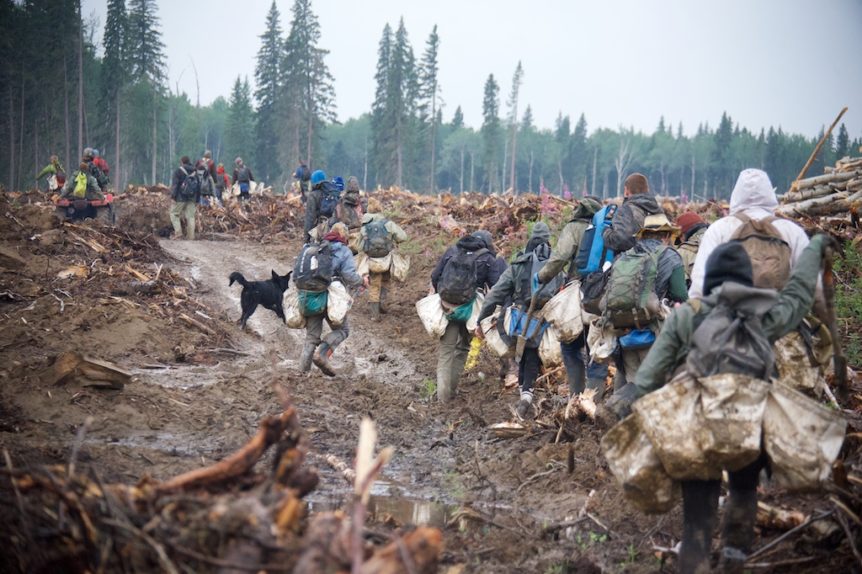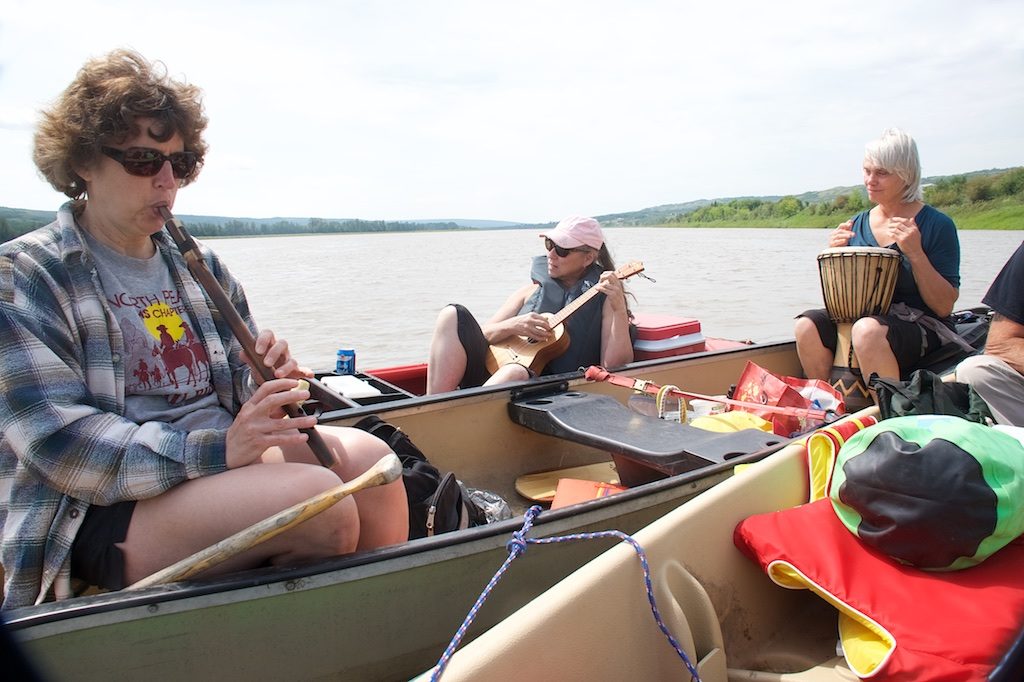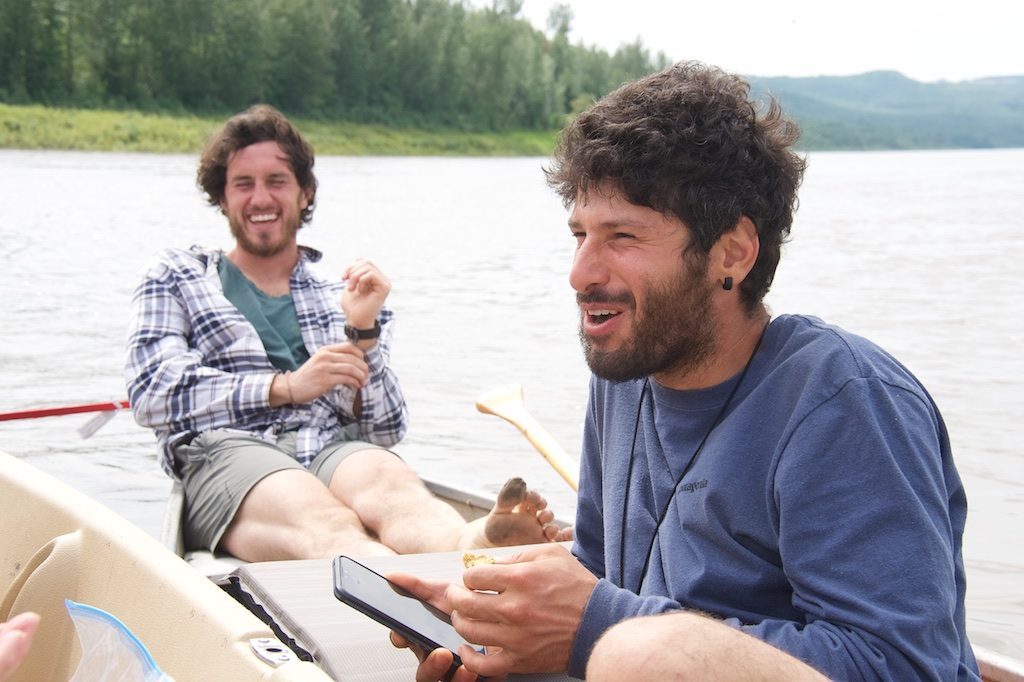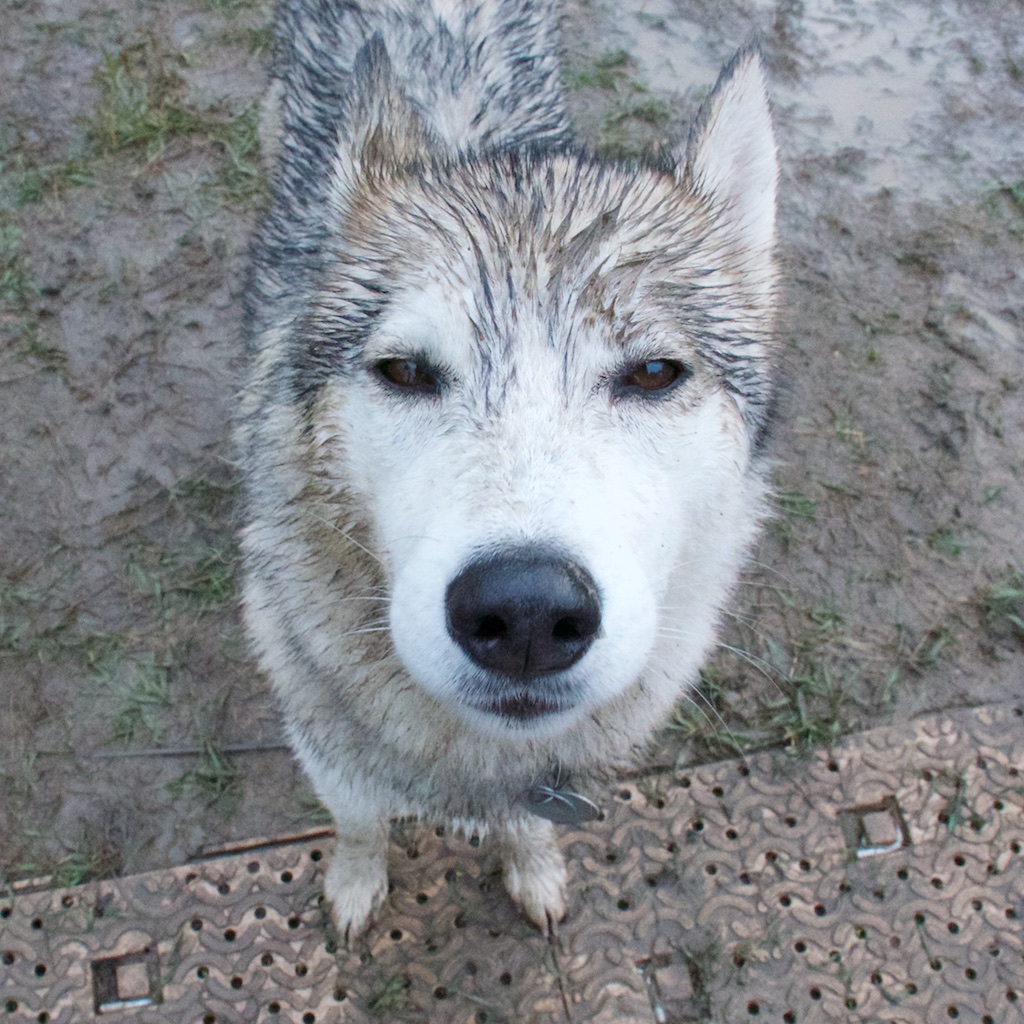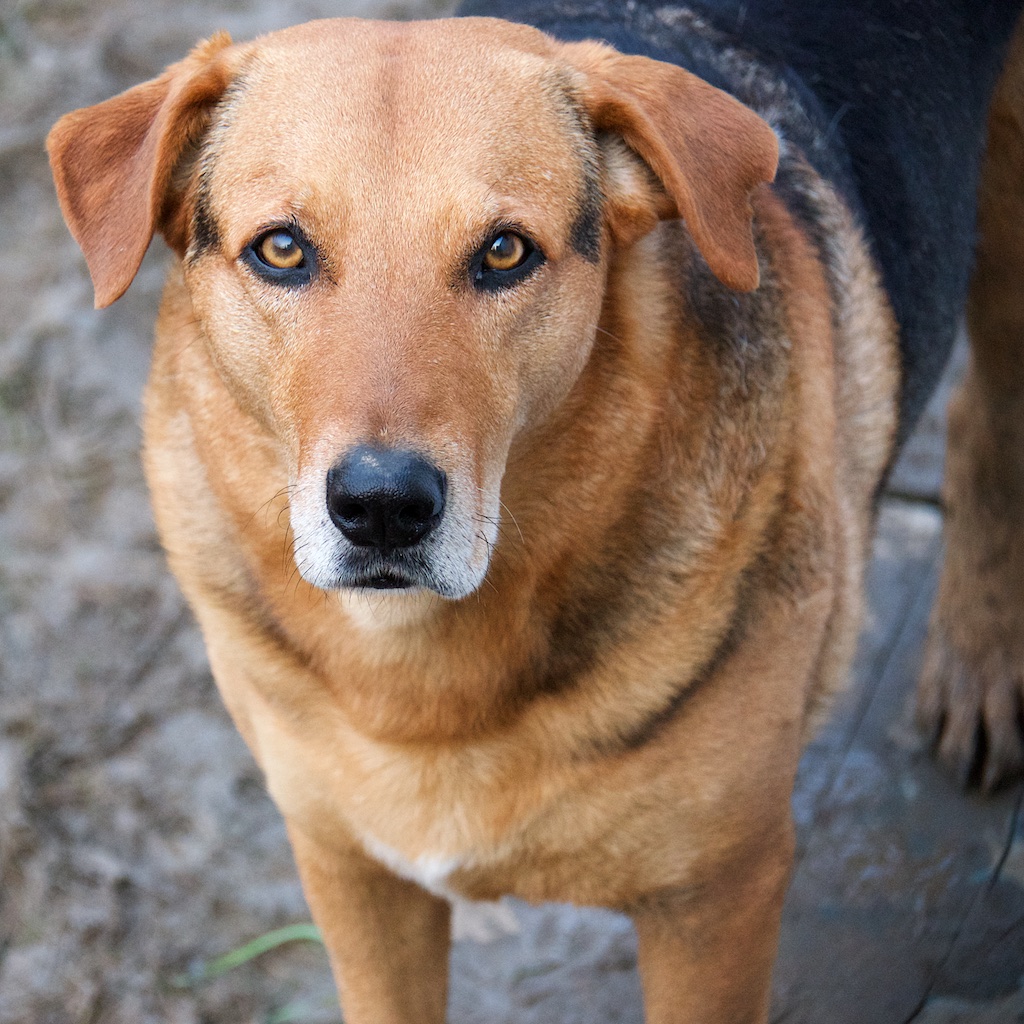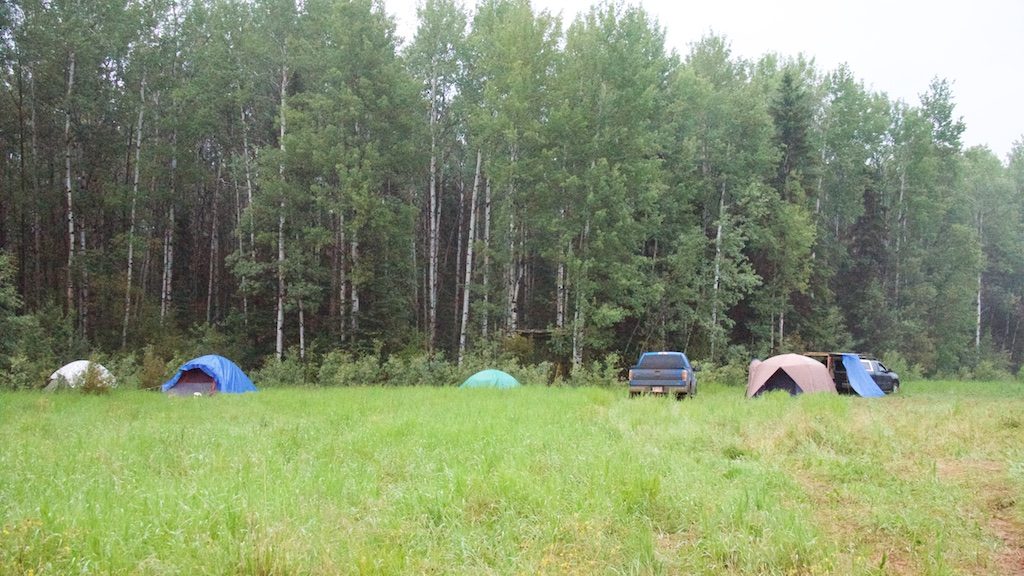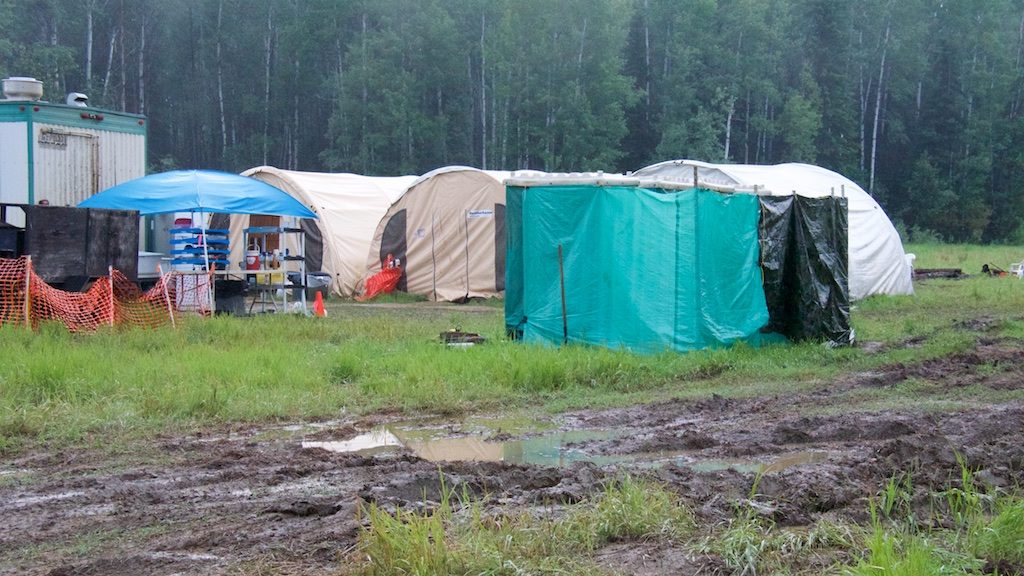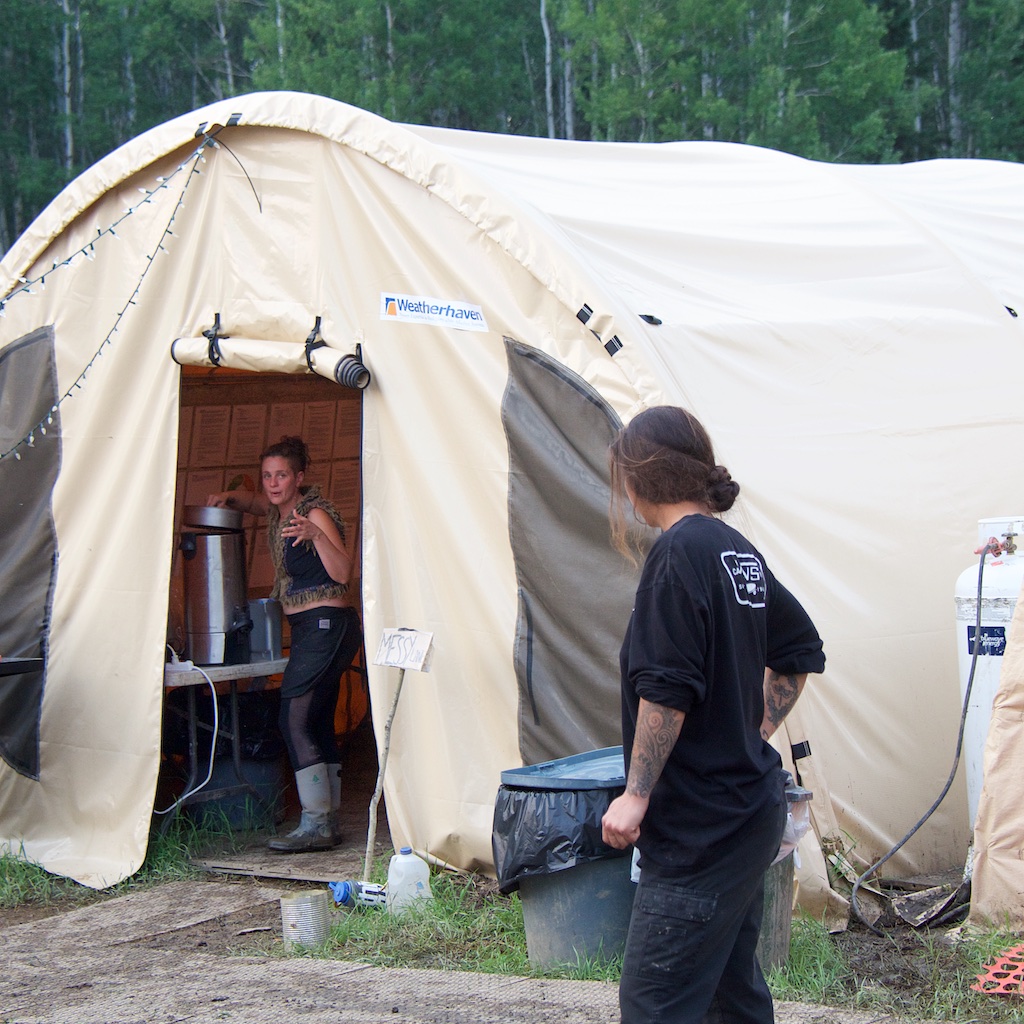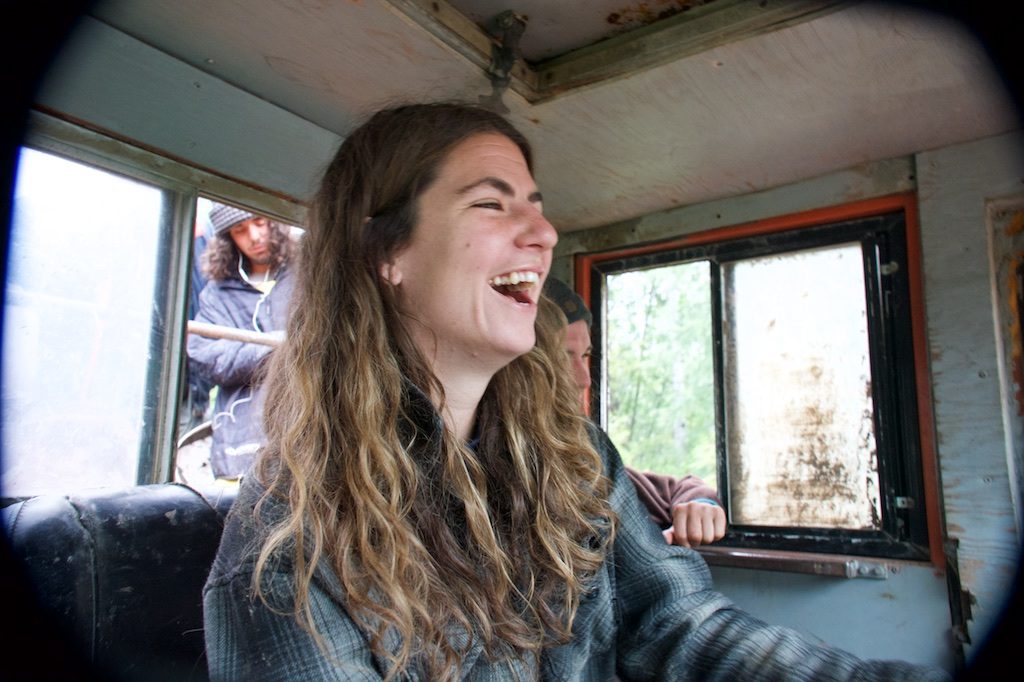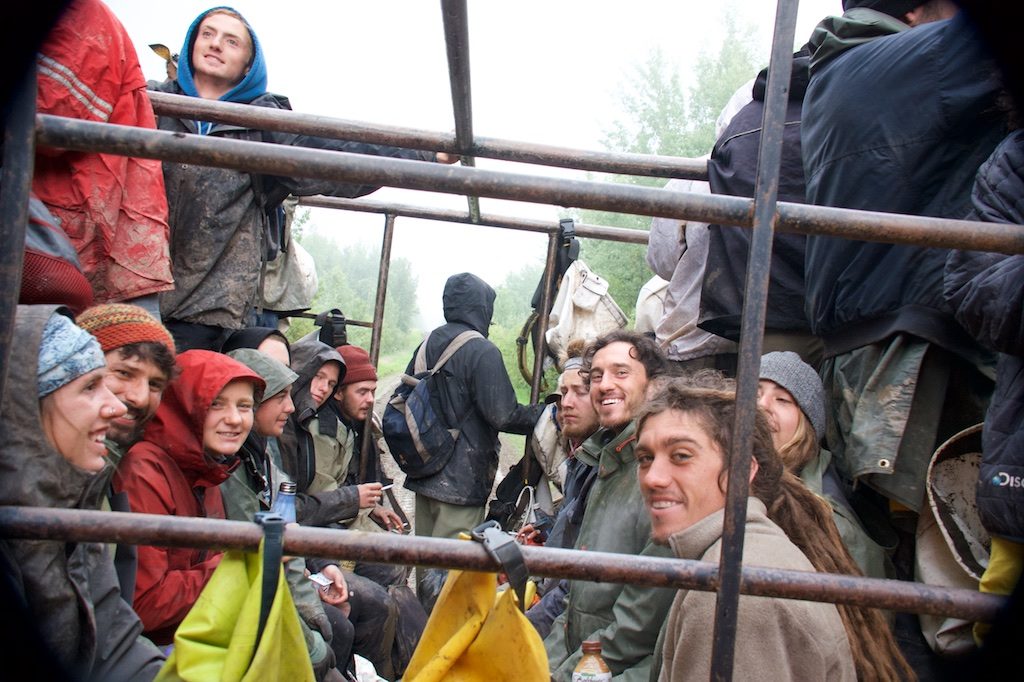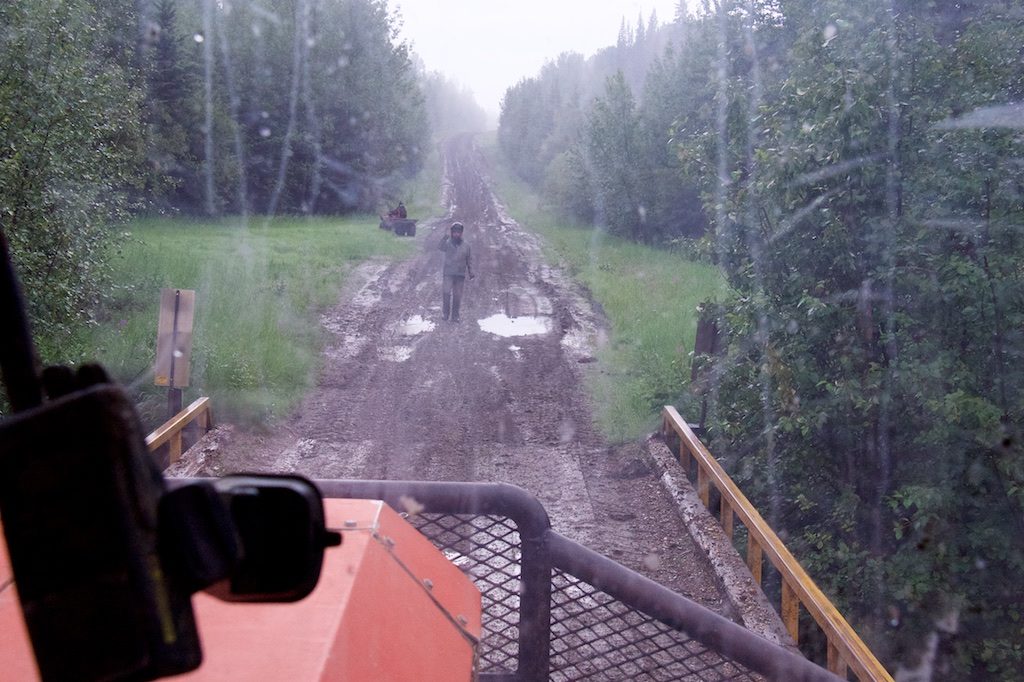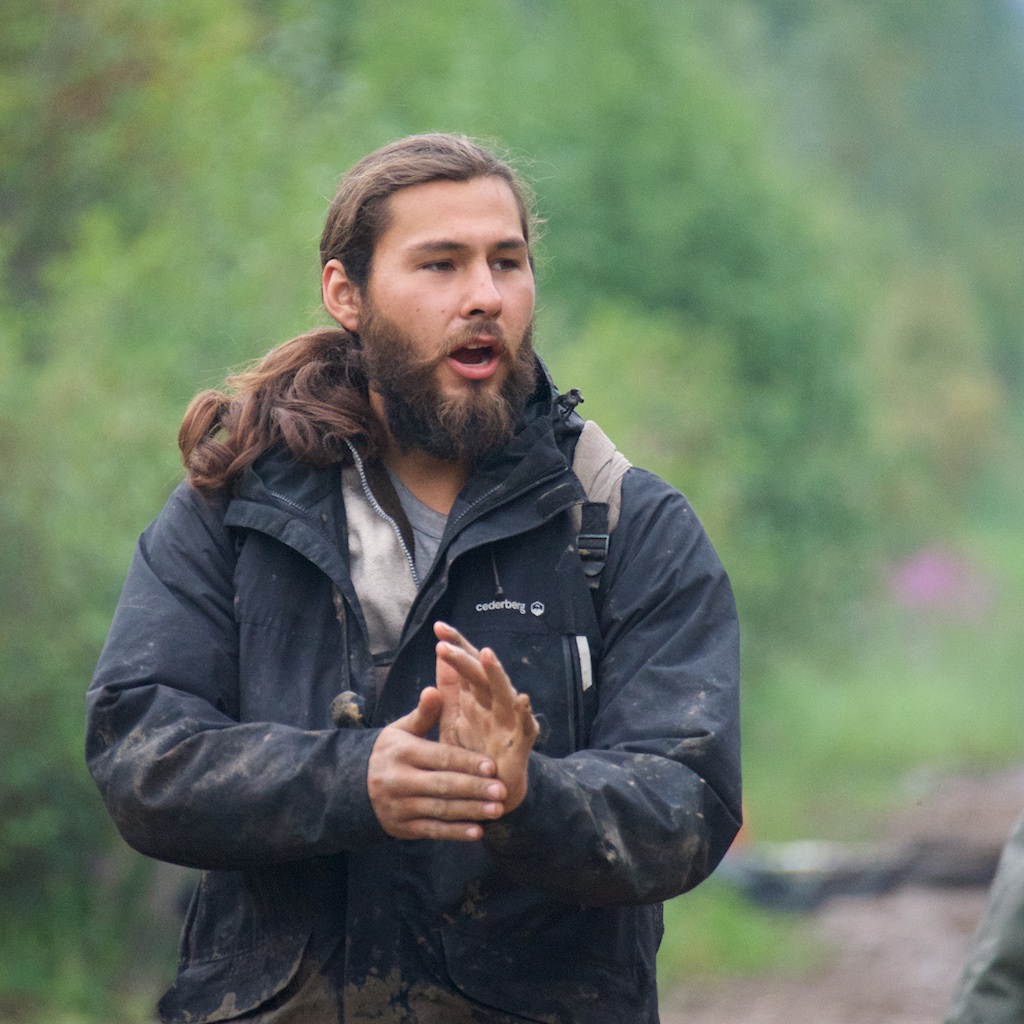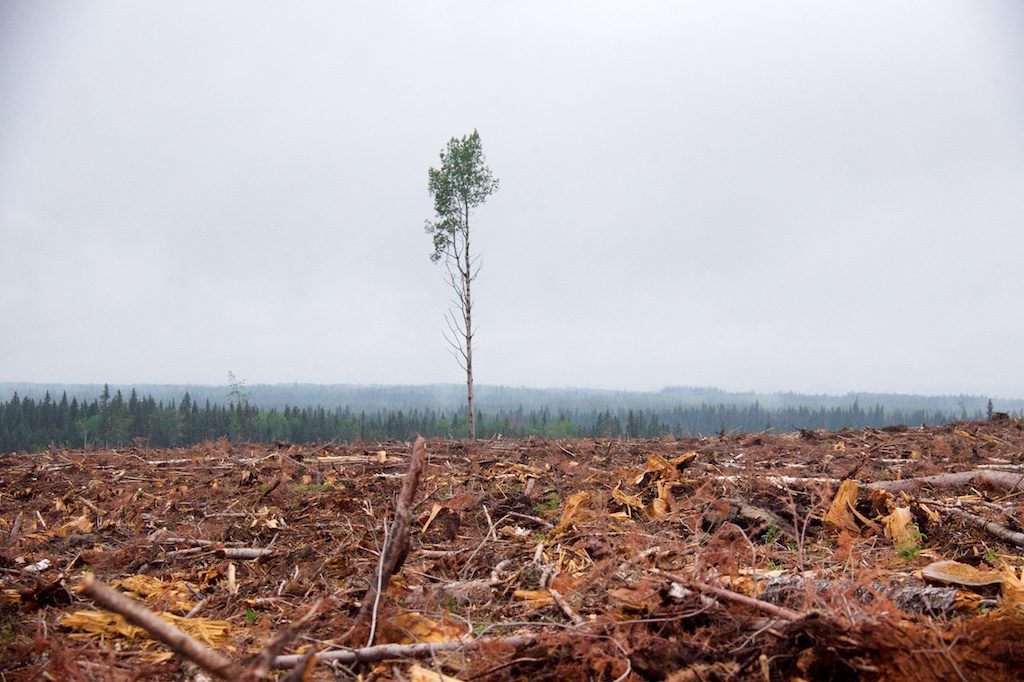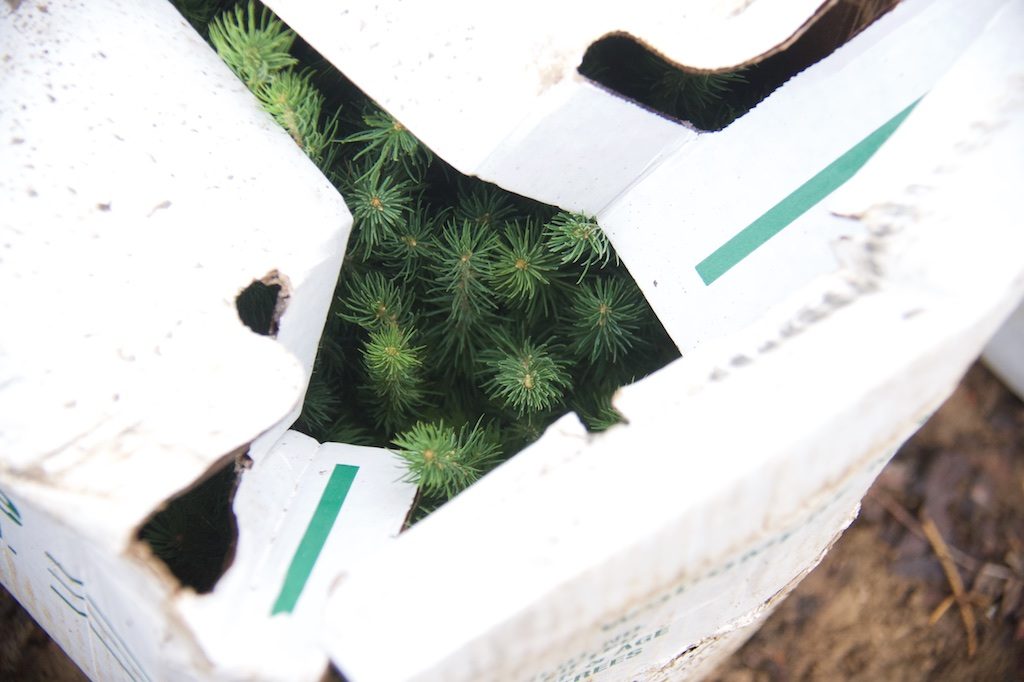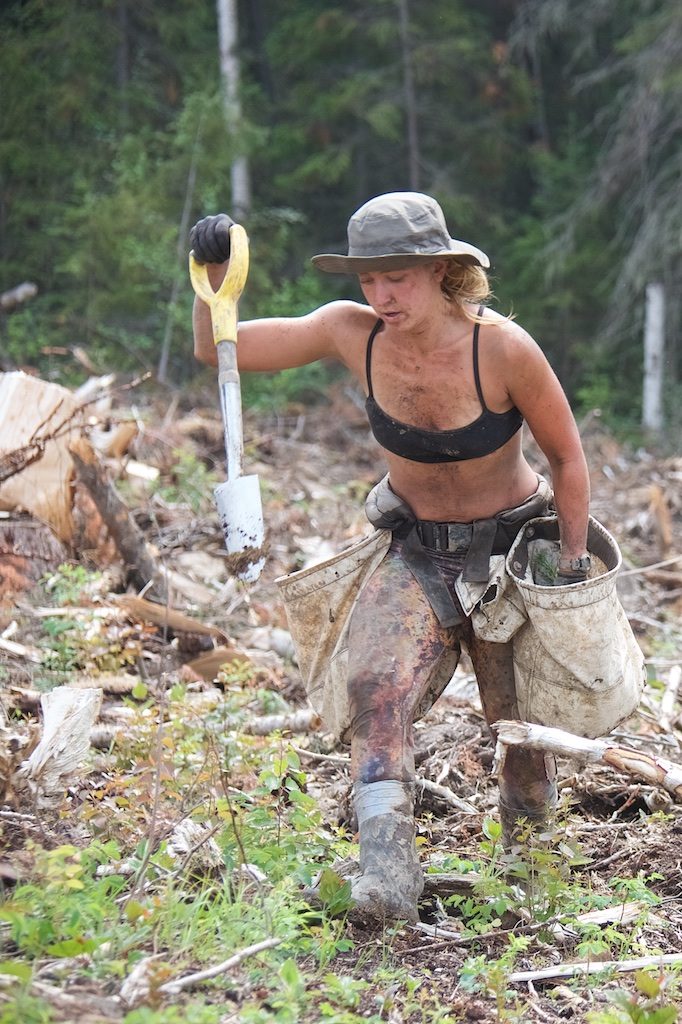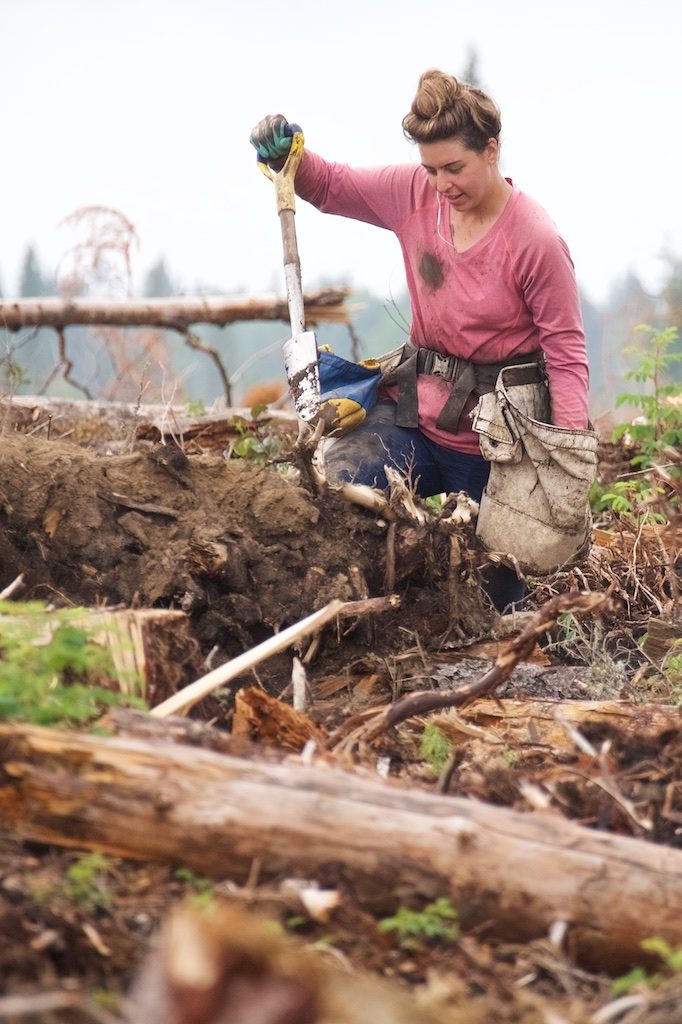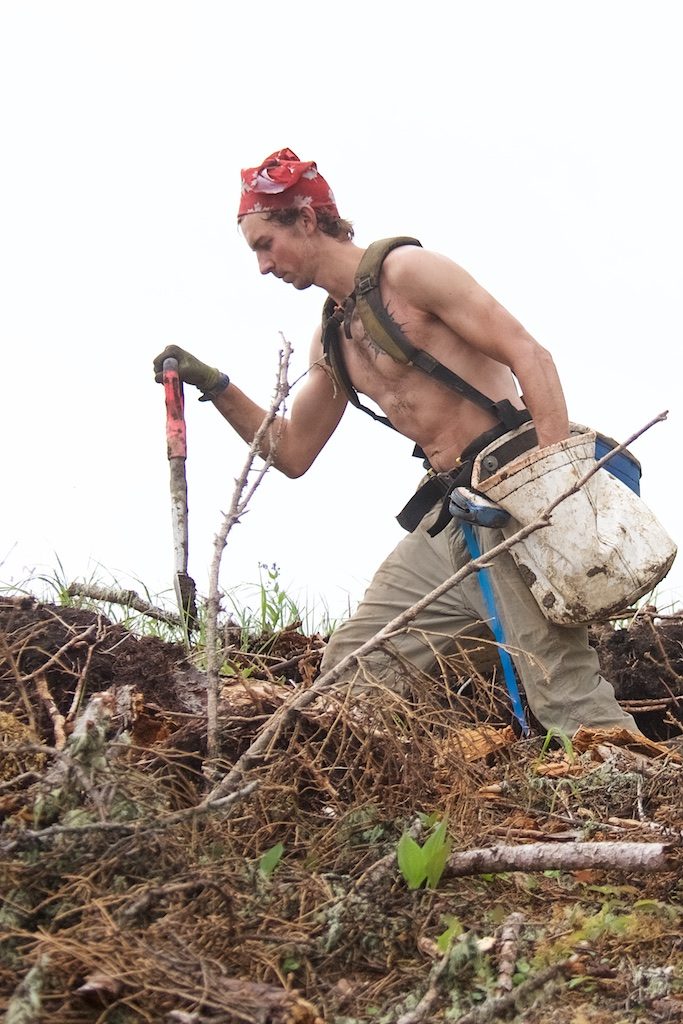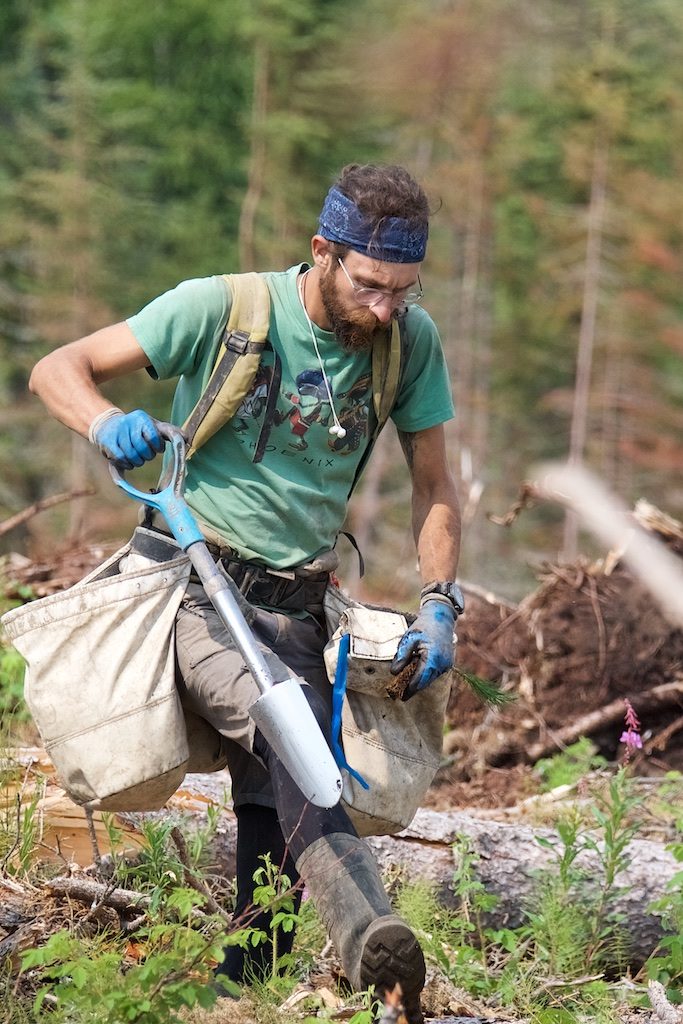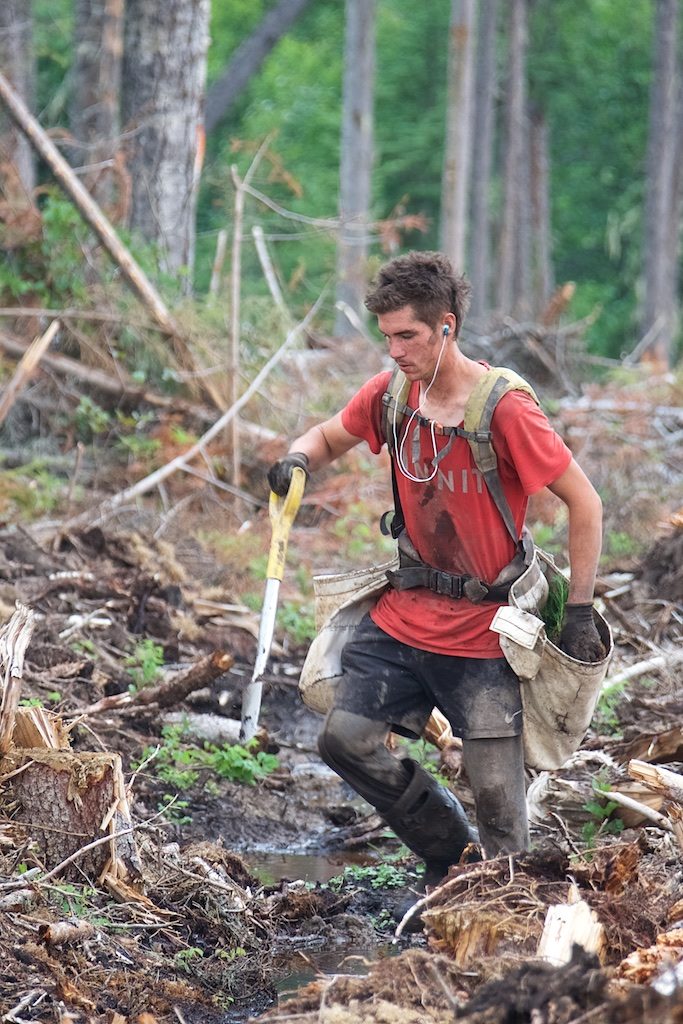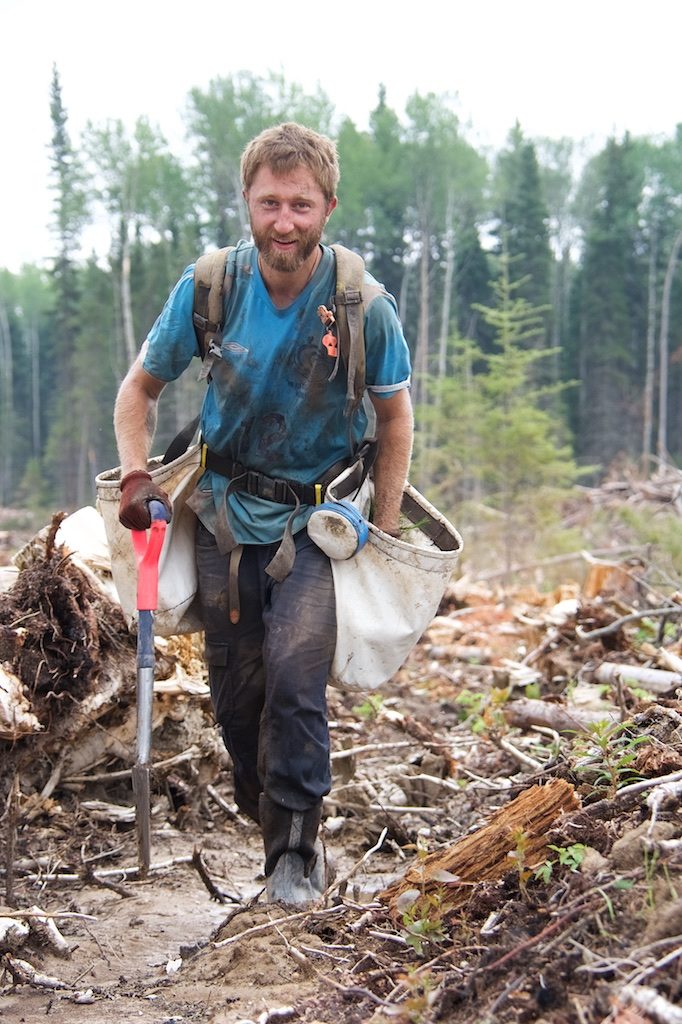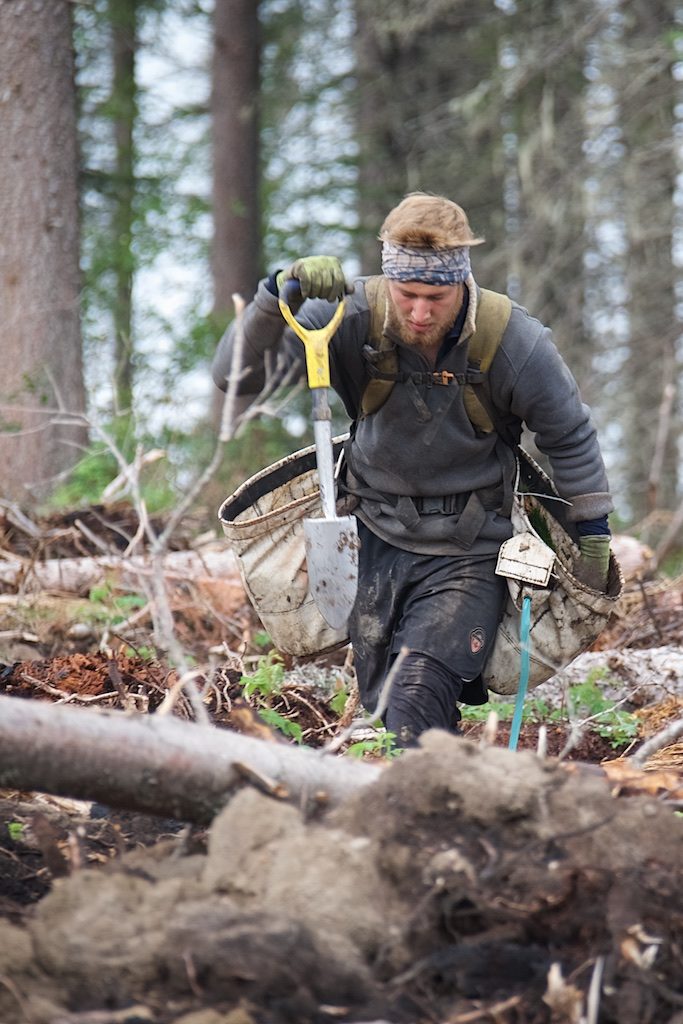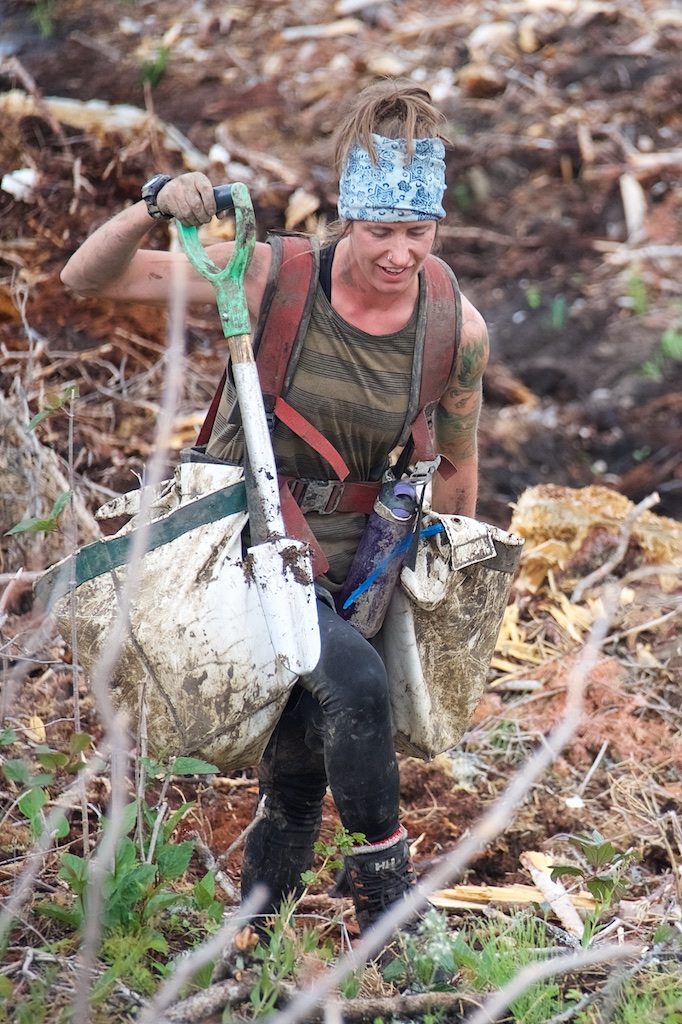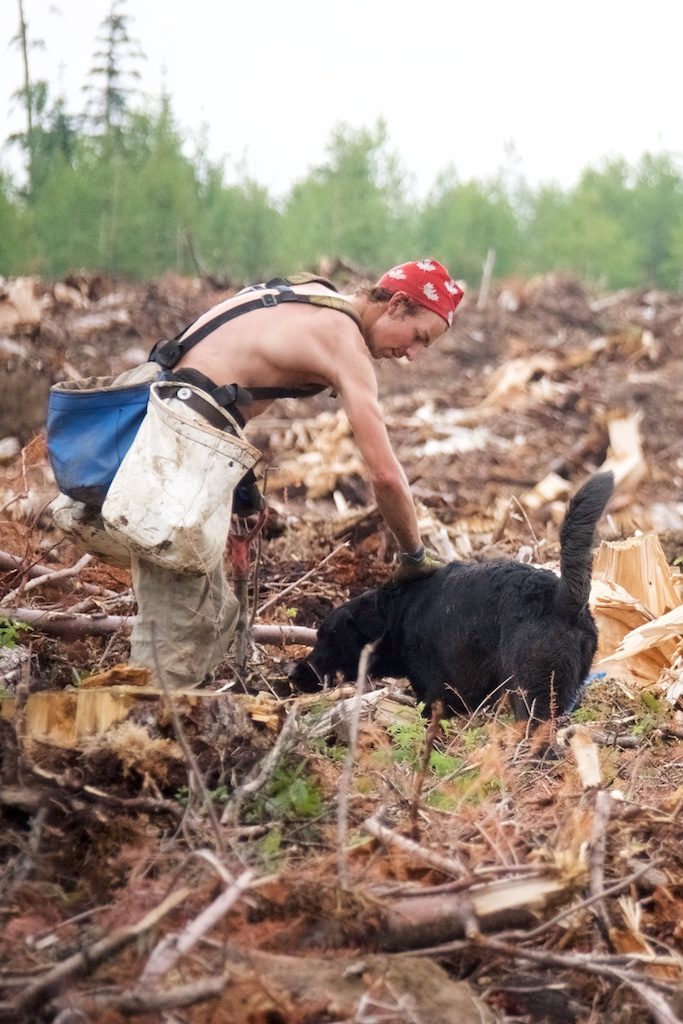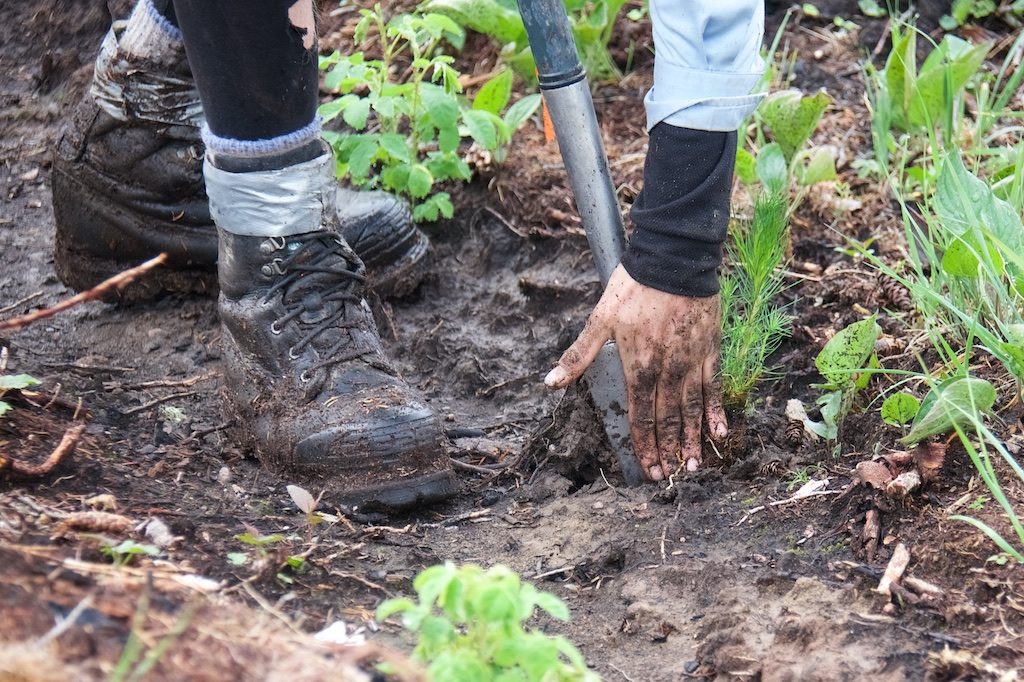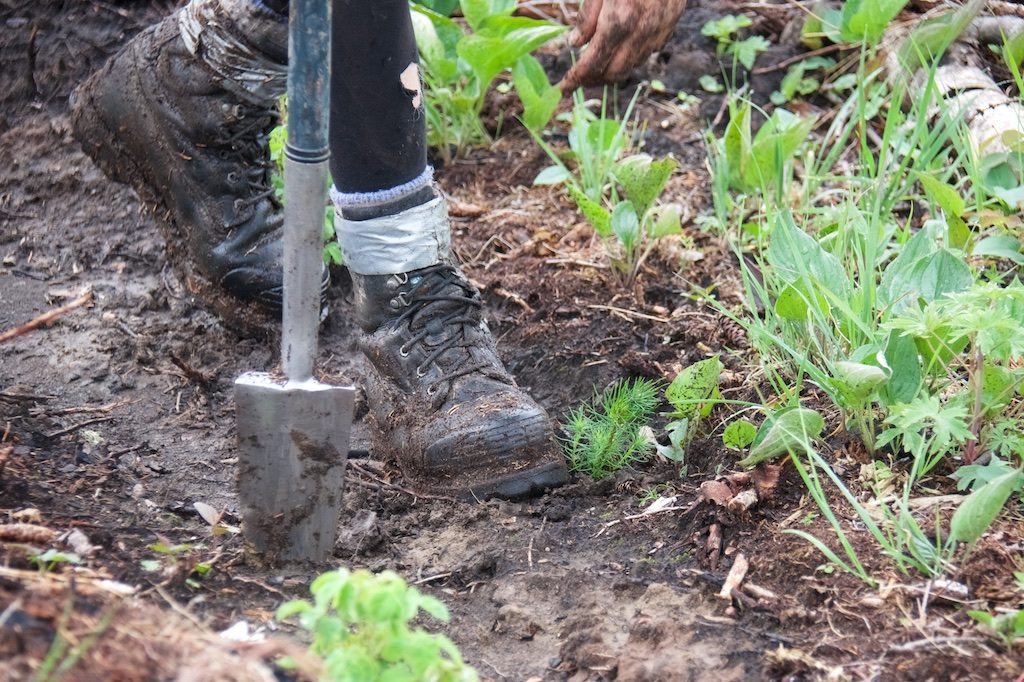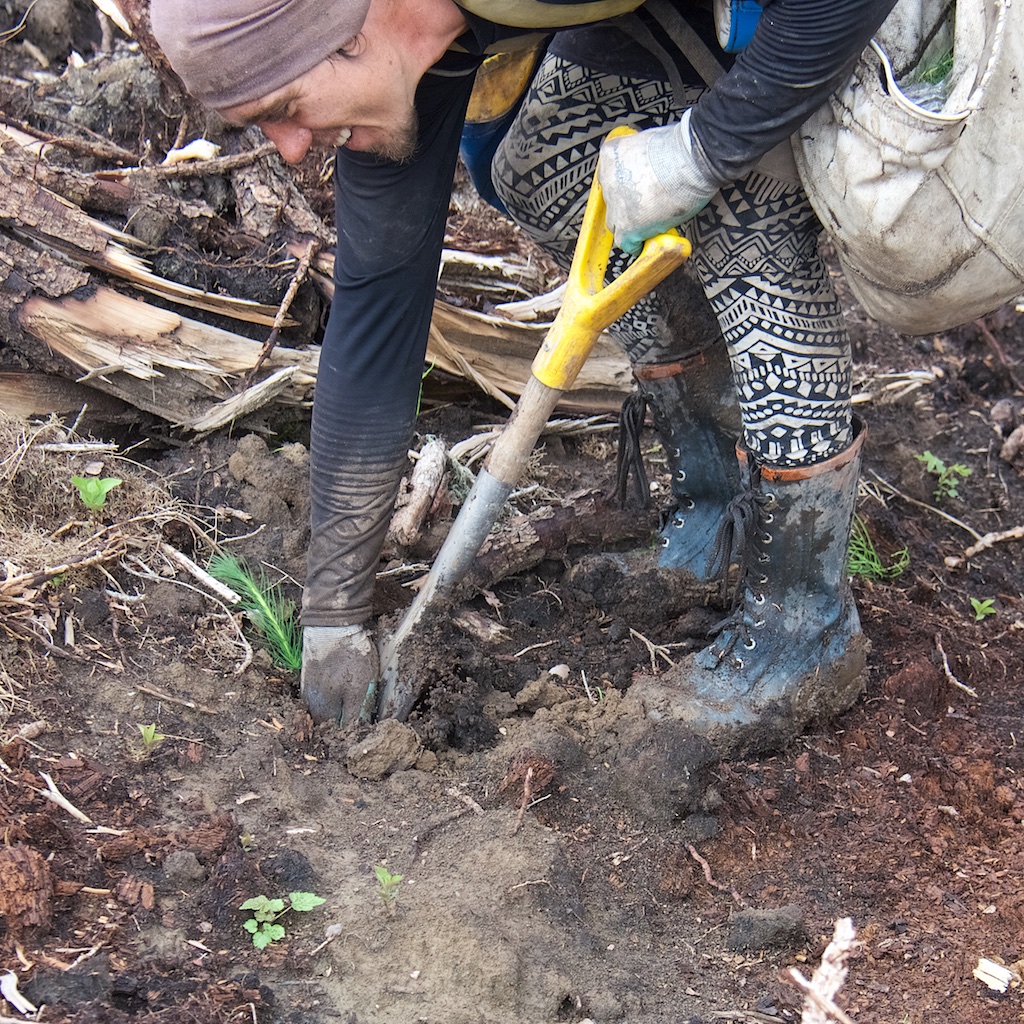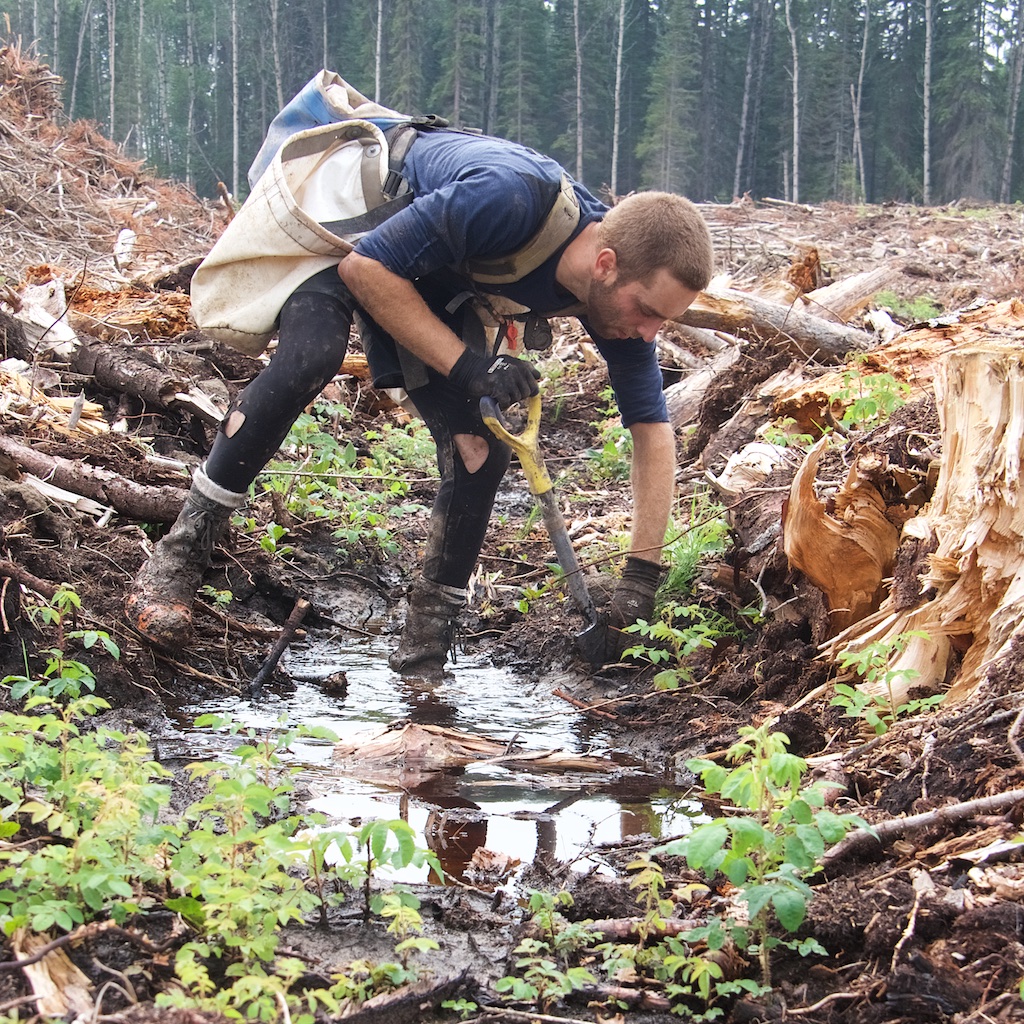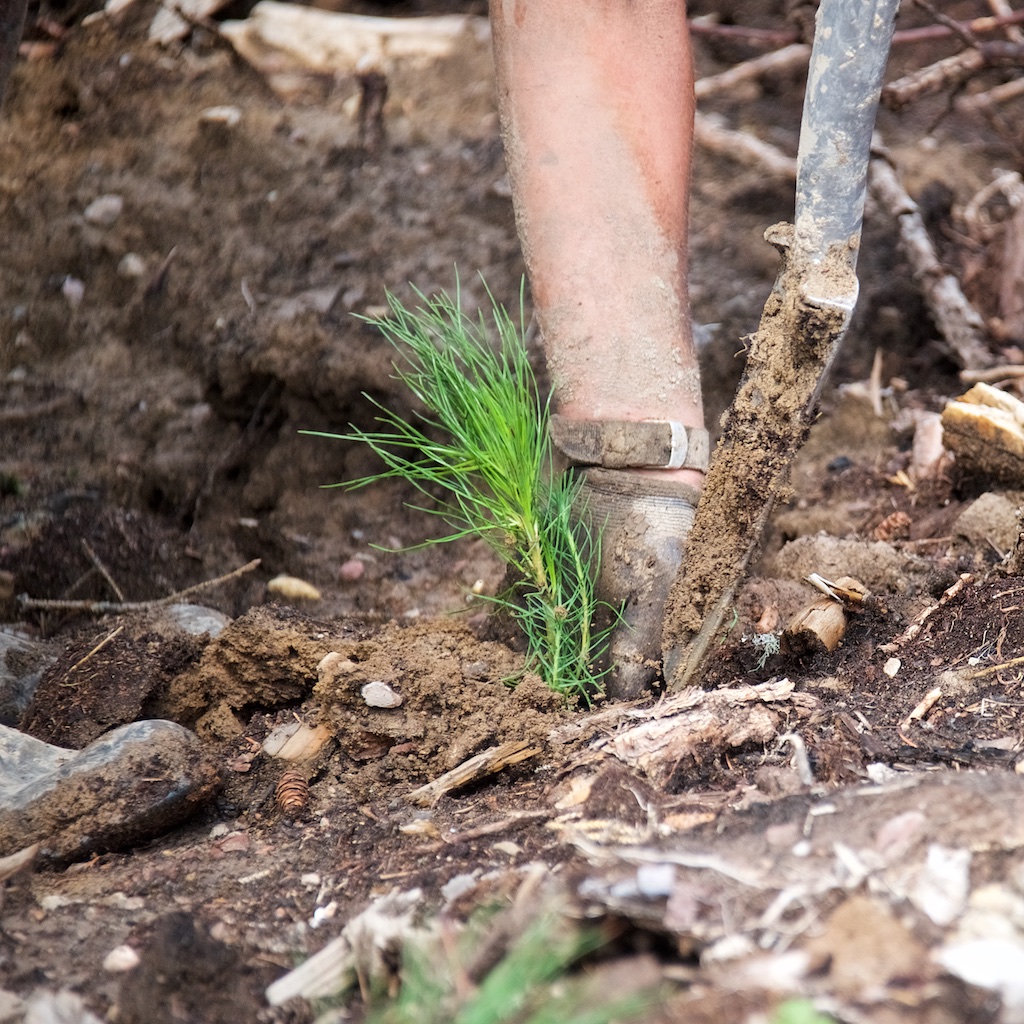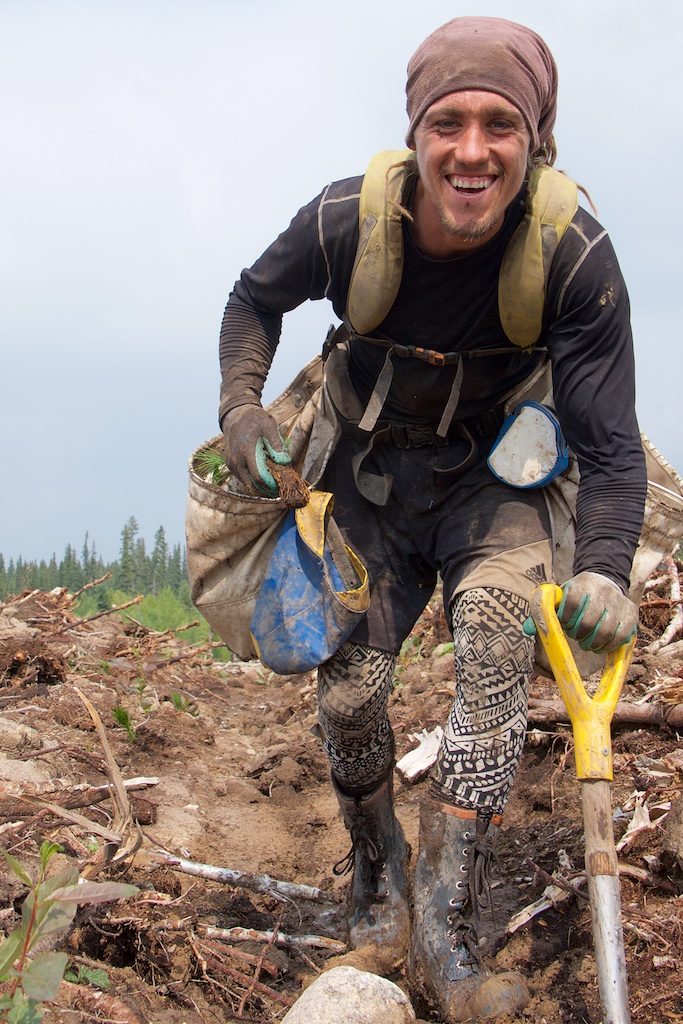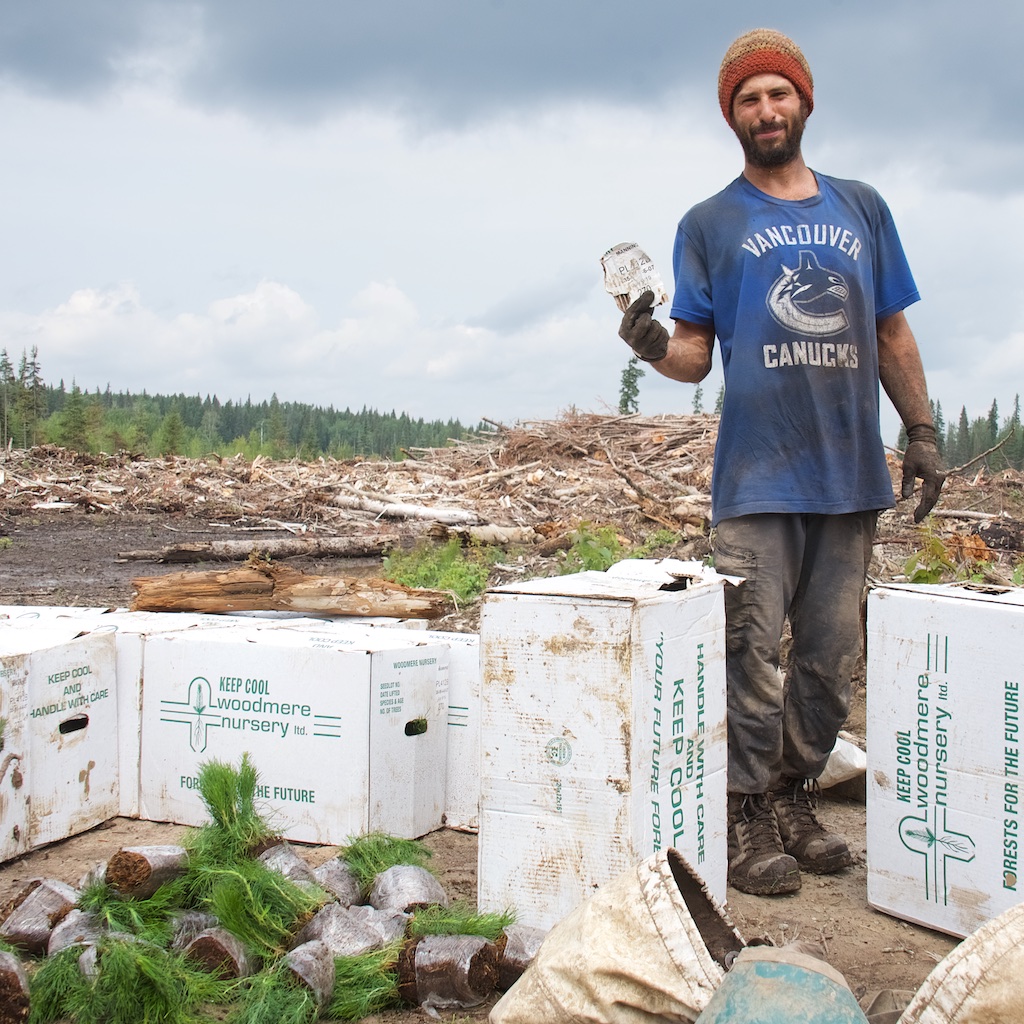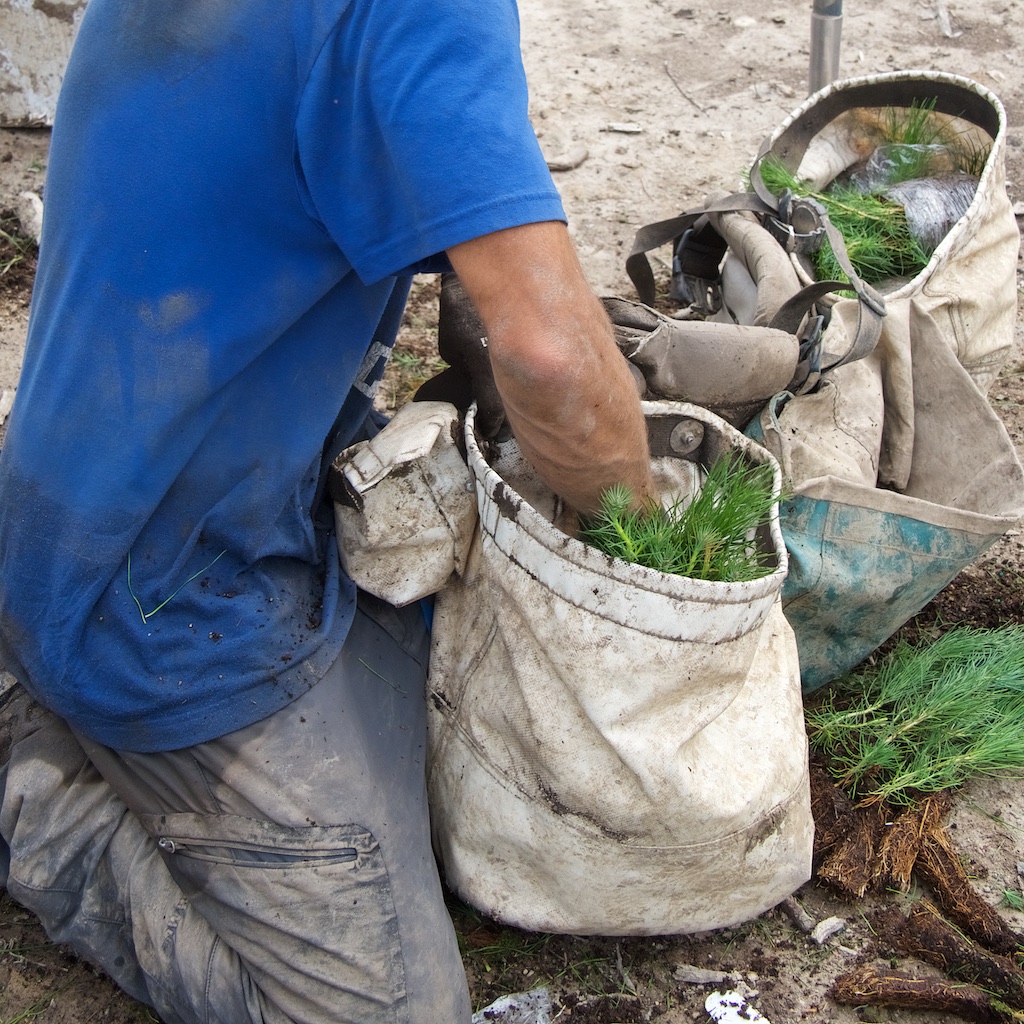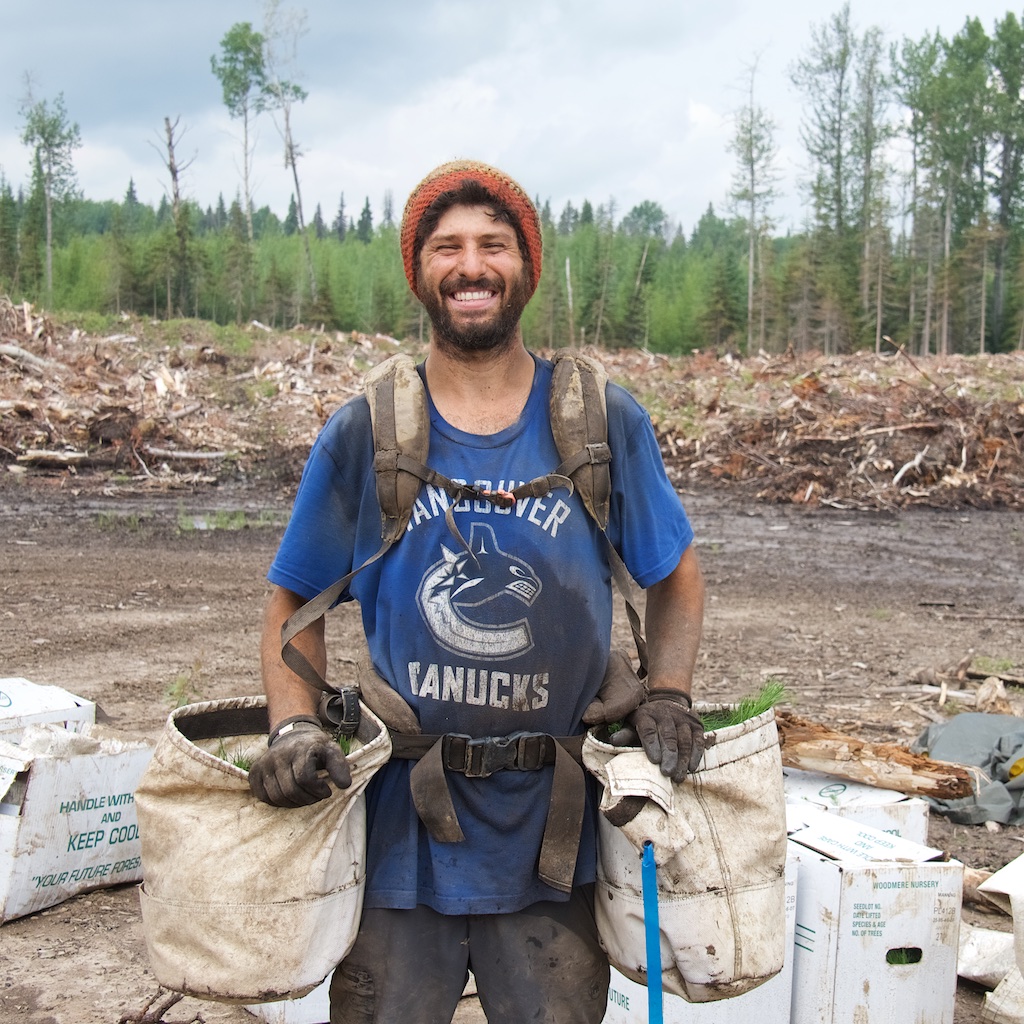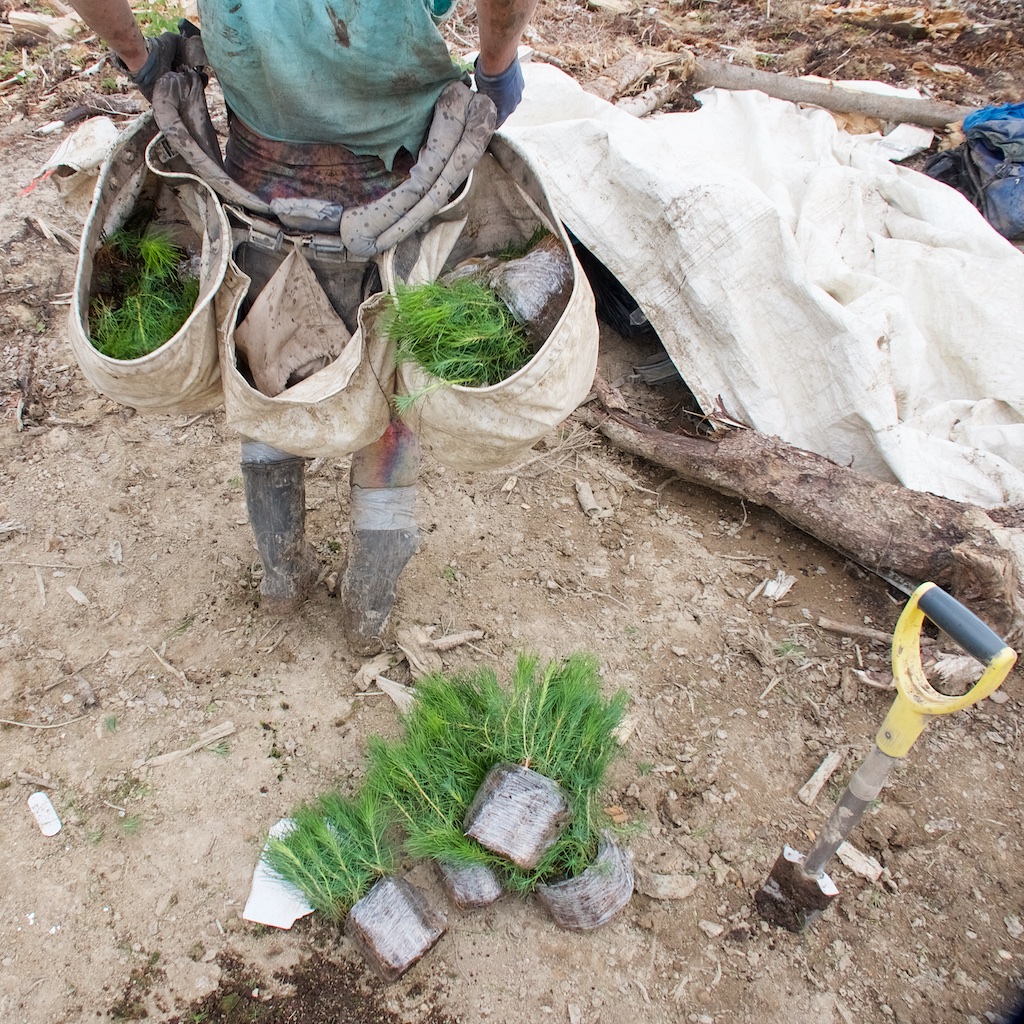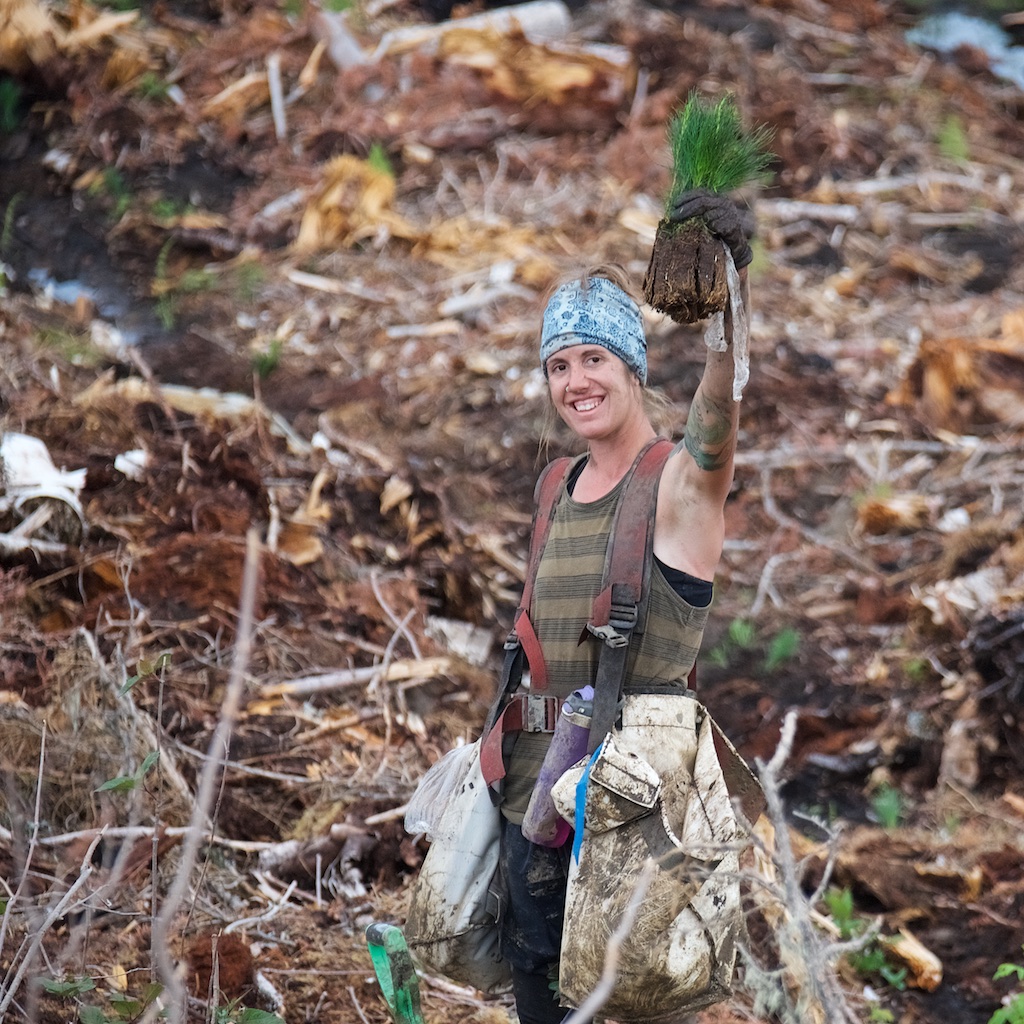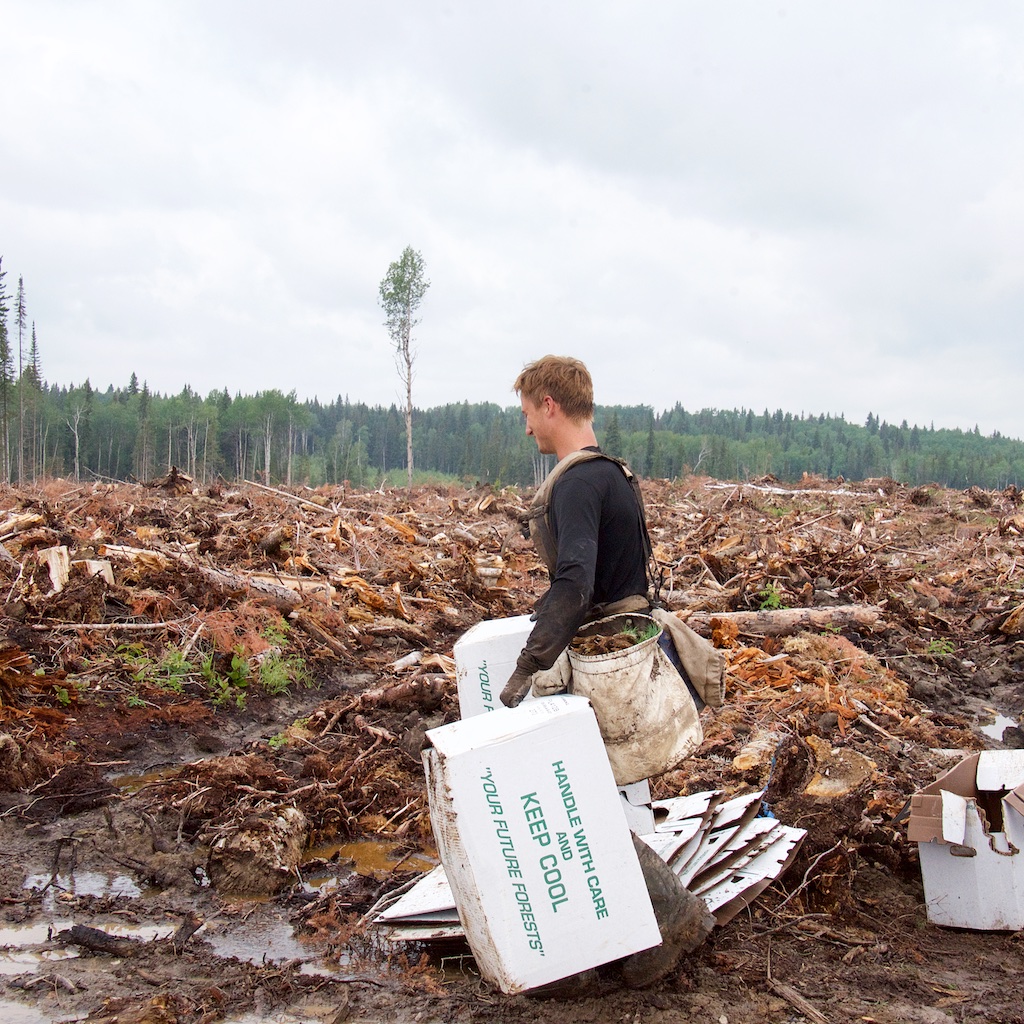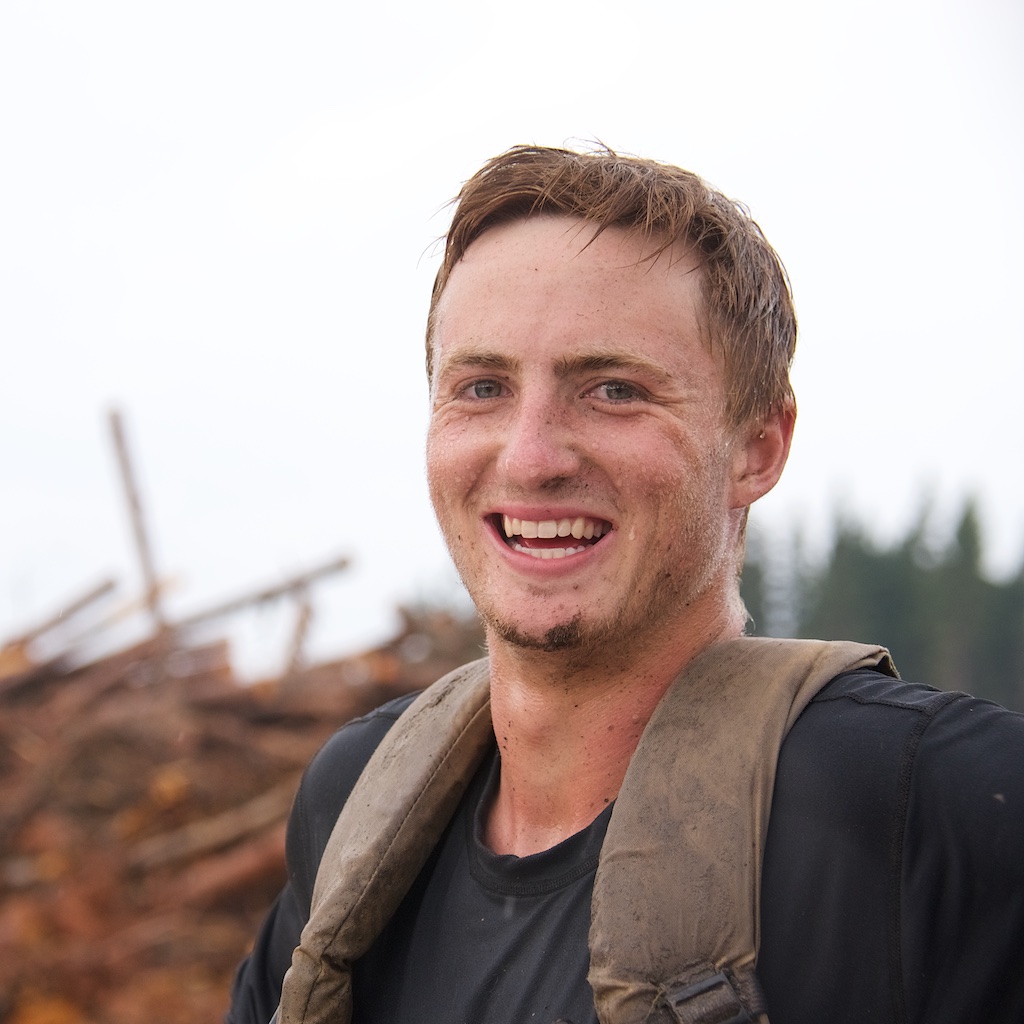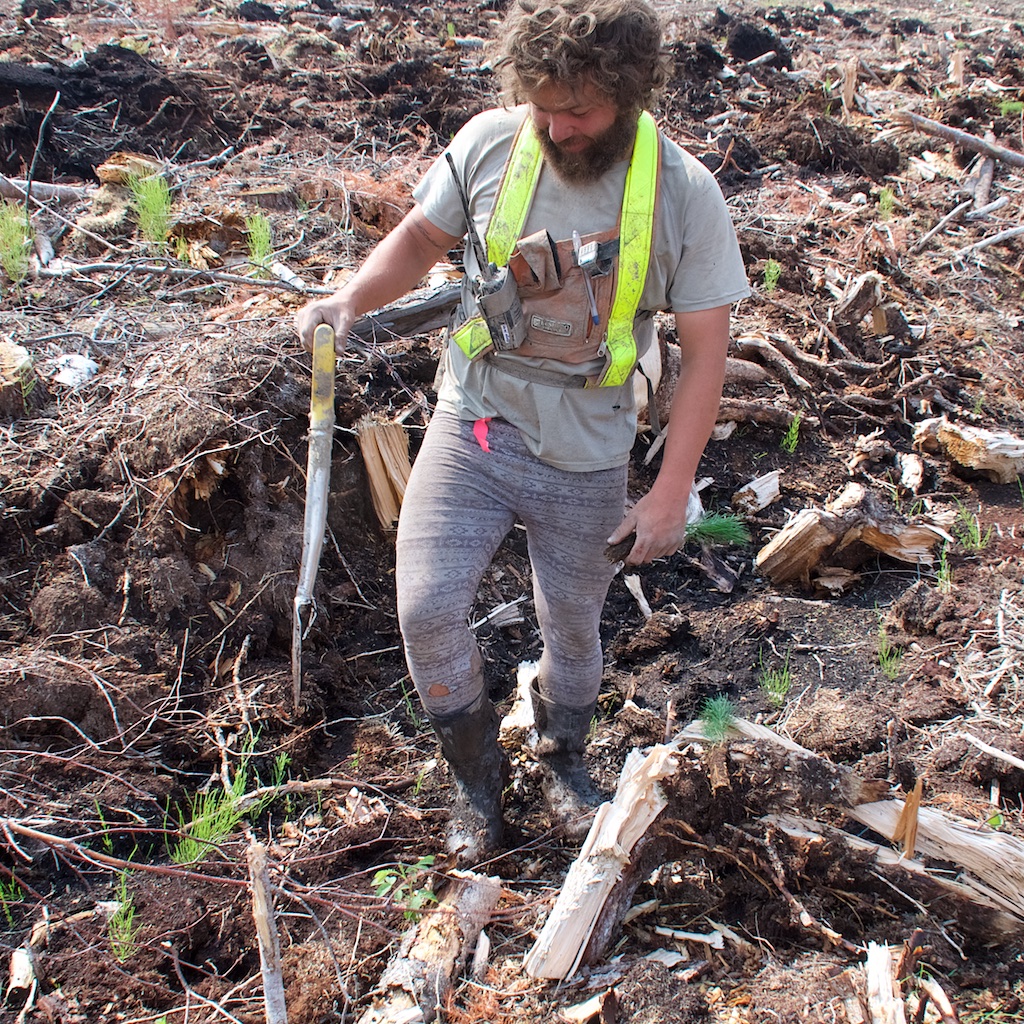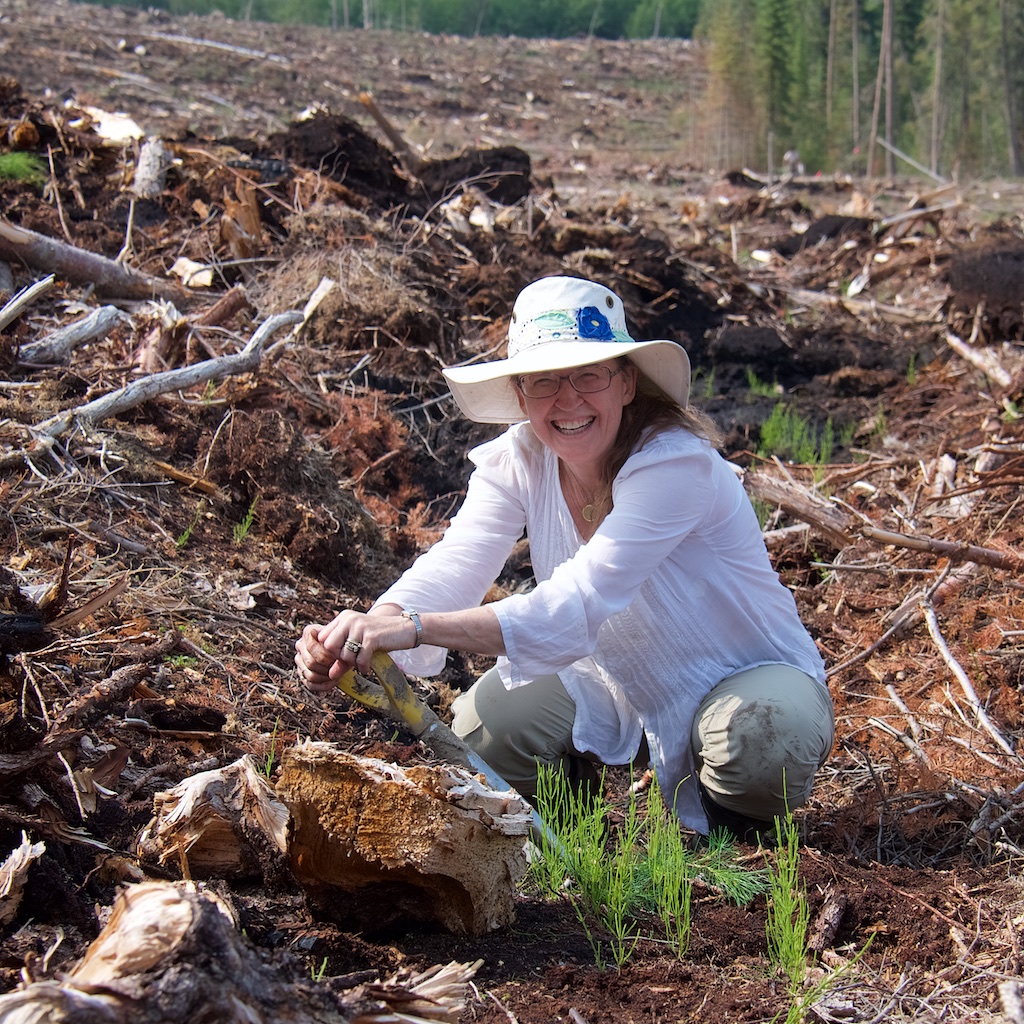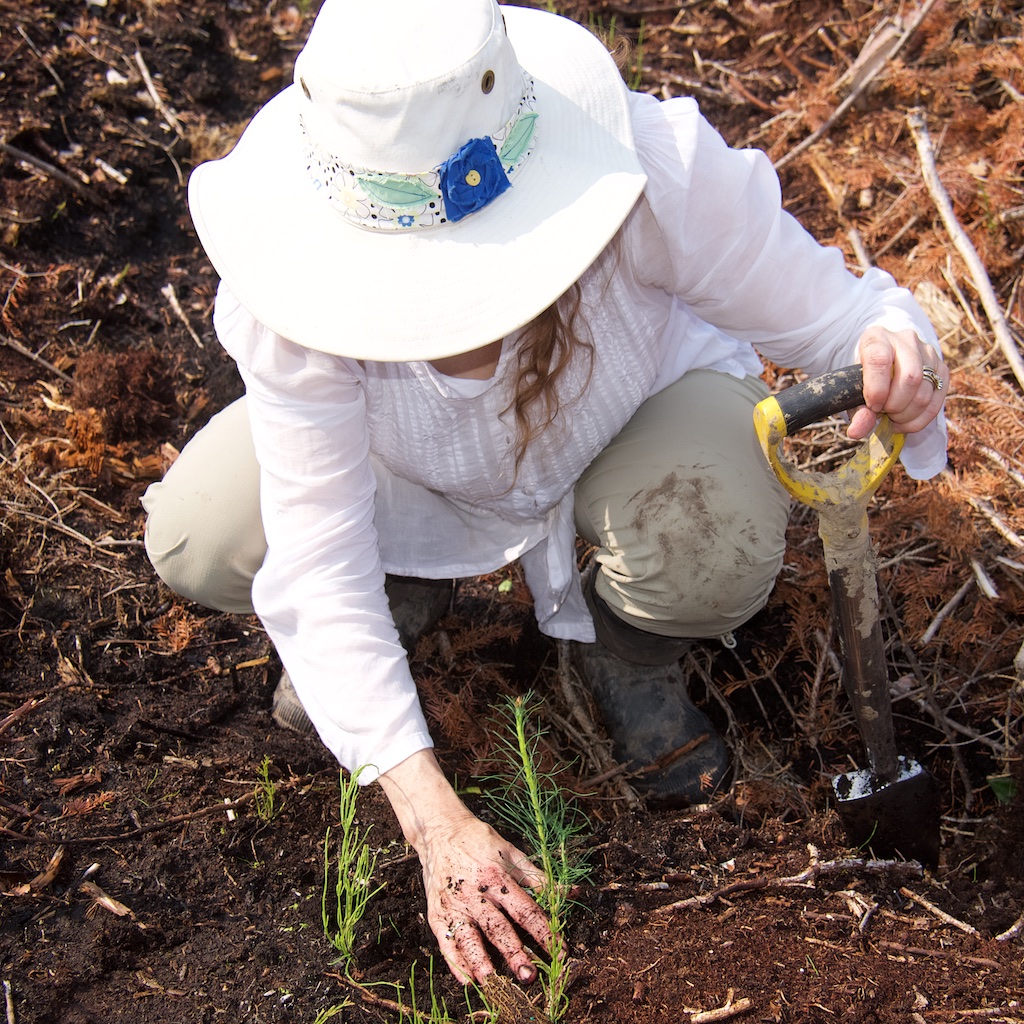A Tree Planting Photography Adventure
by Sharon Krushel, Peace River, Alberta, 2019
This is the story that inspired the card May the Forest Be With You.
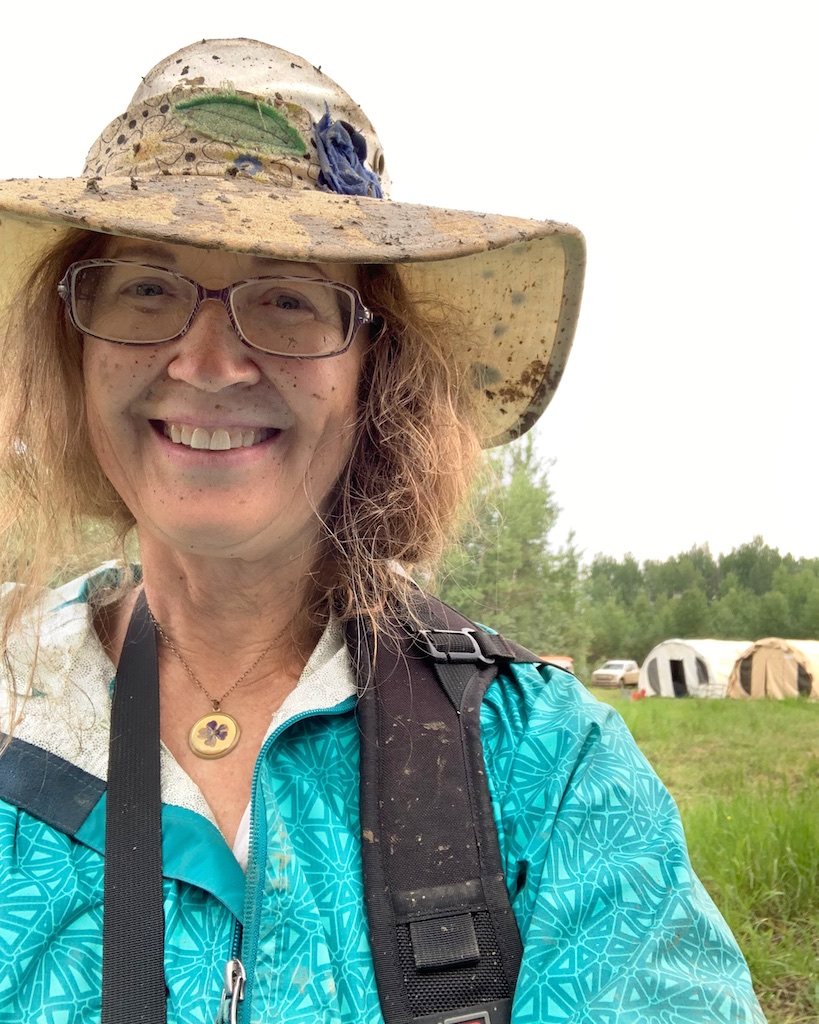
Forward
I’d like to introduce you to some truly amazing people – a camp of incredibly hard-working healers of the forest in the Chinchaga wilderness of northern Alberta.
Think of this as a boreal storybook with lots of pictures and some fold-out pages (links) revealing rabbit trails you can scamper down if they pique your curiosity. As you hike through these chapters, and skip over the bridge to Part 2 of the story, may you discover pieces of light, personalities with a myriad of colours, sprinklings of humour, and some inspiring ideas for climate change action.
If you or anyone you know is searching for a crazy-challenging, endurance-testing, ecologically-vital summer job, read on. Canada needs more tree planters!
Chapters:
Part 1
1 – Floating Down the River
2 – Going to Camp
3 – The Rollagon Ride
4 – At the Cut Block
5 – The Wildlife
6 – The Purpose
7 – Their Stories
8 – Mission Accomplished
9 – Community – Niko’s Photos
10 – Oh Deer! My Name Is Mud
11 – The Gift of Trees and Friendship
Climate Change Action Inspired by Tree Planters
Chapter 1 – Floating Down the River
On a beautiful July day with the sky hinting of rain, I floated down the mighty Peace River with a group of musical friends. We tied two canoes, a Jon boat and a kayak together, brought food to share, a dog named Daisy, a couple of ukuleles and five umbrellas, and off we went.
Fellow music teacher, Joan Blench, brought a wooden flute, a small djembe drum, and the two tree planters who were staying at her Airbnb on their days off. In the six hours of summer bliss, singing, and fascinating conversation that followed, we discovered that Imad is from Montreal, though originally from Lebanon, and has a degree in Environmental Science. Eddy is from Pennsylvania and was teaching English as a second language in China where he met Imad, who was visiting his sister and helping her and her engineer husband with the marketing of the lightweight Carbo foldable e-bike they had designed. Imad had invited Eddy to come to Alberta with him for the tree planting season.
And here we all were, sitting on a makeshift little island floating down the Peace River sharing stories from around the world. Imad sang us a Lebanese song, and we introduced Eddy to the classic Canadian folksong, “The Log Driver’s Waltz.”
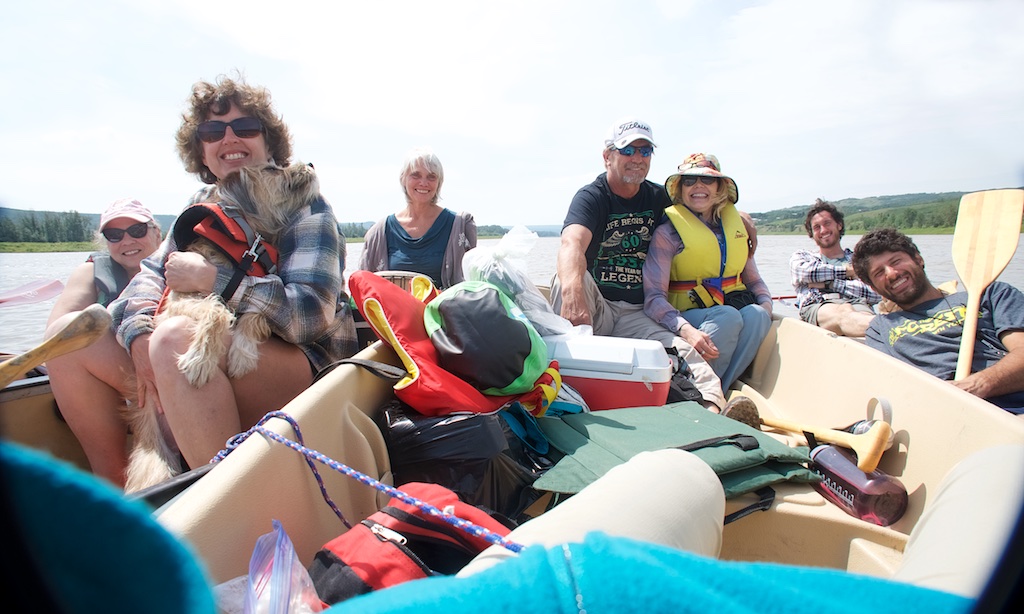
Two tree planters, Eddy and Imad, join Diana, Joan, Audrey, Miles, Darrilyn, (and Sharon on camera) for a six-hour float down the Peace River
I was intrigued with these tree planters’ stories and, somewhere between putting in at the Shaftesbury Ferry dock and getting out at the West Peace boat launch, I volunteered to go photograph Imad and Eddy and their comrades planting trees in the Chinchaga Wilderness northwest of Manning.
In 2016, I had designed a card called “Boreal Forest Nymph” and put “May the forest be with you ;)” on the back of the card. And now here was that same StarWars-ish blessing on the front of Imad’s shirt. The wheels started turning…
Chapter 2 – Going to Camp
Eddy and Imad made arrangements for their manager, Maya, to contact me. She phoned with an enthusiastic invitation and directions to the camp, 42 km down the Chinchaga Forestry Road. It had been raining, and the forecast was for more rain so she asked if I had a 4×4. I said I had an all-wheel-drive Chevy Travers. “Um…” She didn’t sound impressed, so I said, “My husband has a Ford F150 4×4.” She said, “Ya, you’d wanna snap that up for sure.”
It was a B.Y.O.Tent adventure, so I embarked on an archaeological dig in our basement and managed to uncover the Mountain Equipment Co-op “Funhouse 4” tent I had used years ago in the Alberta Badlands. I borrowed an air mattress from my friend, Bob, packed up my camera gear, put on my rain gear, stepped into my tall black Cougar rubber boots, loaded everything in my husband, Terry’s, beautiful blue first new truck ever. He gave me a kiss good-bye, wished me luck, and as I backed out the driveway, shouted, half in jest, “Don’t wreck my truck!” I laughed, “Okay!” and was on my way.
Heading north on the MacKenzie Highway, I drove through Manning and past the sign for Hotchkiss and finally saw the sign “Chinchaga Forestry Road”.

Chinchaga Forestry Road, northwest of Manning, Alberta
“This isn’t so bad,” I thought, as I headed west. However, like many side roads I’ve driven down, it starts out perfectly paved and polite, turns to gravel over the next rise, and then to dirt, or, in this case, mud with lots of dips, ruts and puddles. I had slowed down significantly but the back of the truck was still fish-tailing. Then I remembered Terry said you have to put it in 4-wheel drive; it’s not automatic. Palm of the hand to the forehead. Big difference! But I still couldn’t go very fast if I wanted to keep it between the ditches.
It’s a good thing my brother, Harlan, and I played in the mud a lot as kids on the farm and that I tend to associate mud with fun, because mud is a key word in this story and my name would be mud by the time I got home.
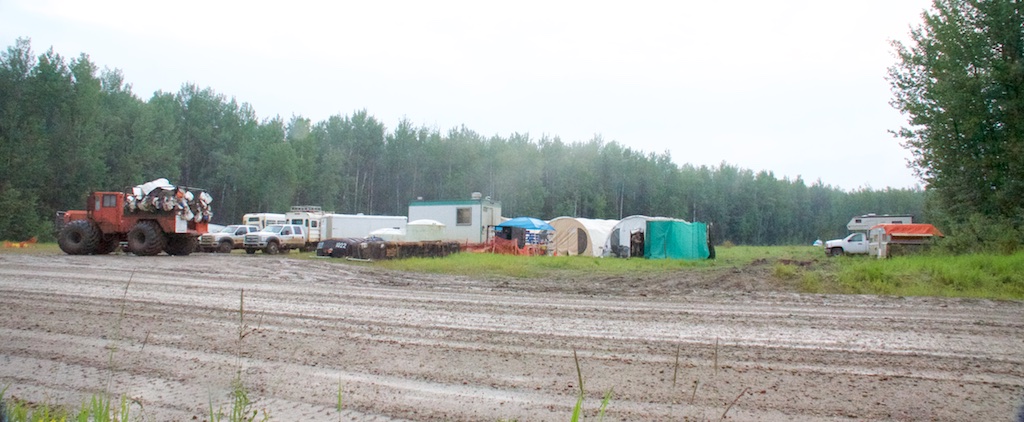
I arrived at the Outland Reforestation camp rather late in the evening. I was delighted to be welcomed by a canine committee; one looked to be part coyote.
- Lucy
- Benny
- Pepper
I thought the tree planters would be housed in big canvas tents with cots or something of that nature. There was a camper and a couple of small holiday trailers (one for the helicopter pilots), but most people stayed in small tents near the trees around a grassy open area. When they said “camp”, they meant camp!
Imad and Eddy took me through the mud puddles on what I would call Main Street and showed me the deep outdoor sinks for getting water, washing dishes, etc. There was a small kitchen trailer (Mel’s domain), a generator, some propane tanks, and a tank of water. Further along, there were showers of a sort.
On the other side of the street, there were three canvas tents. First and foremost was the Dining Tent. Next to that was the “DRY” tent where they showed me clothesline after clothesline hanging with wet muddy garments. There was what looked like a mini Herman Nelson heater in the corner. But still, it didn’t look like anything in there had a hope of drying by morning.
- Tree Planters’ Village – west side
- Showers on the right; covered dishwashing station on the left
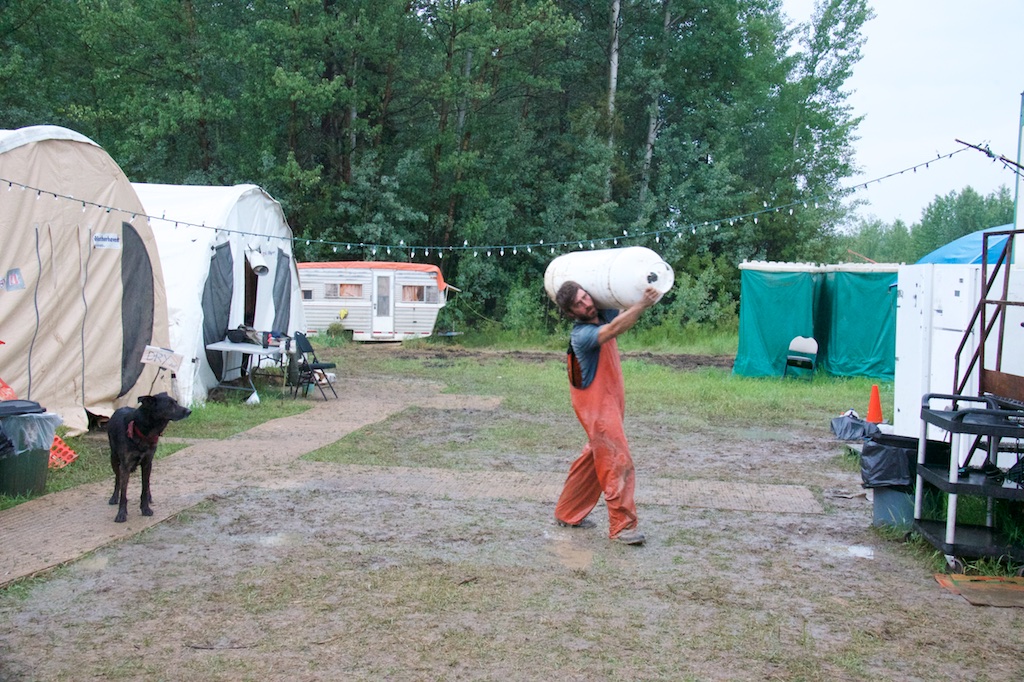
Main Street
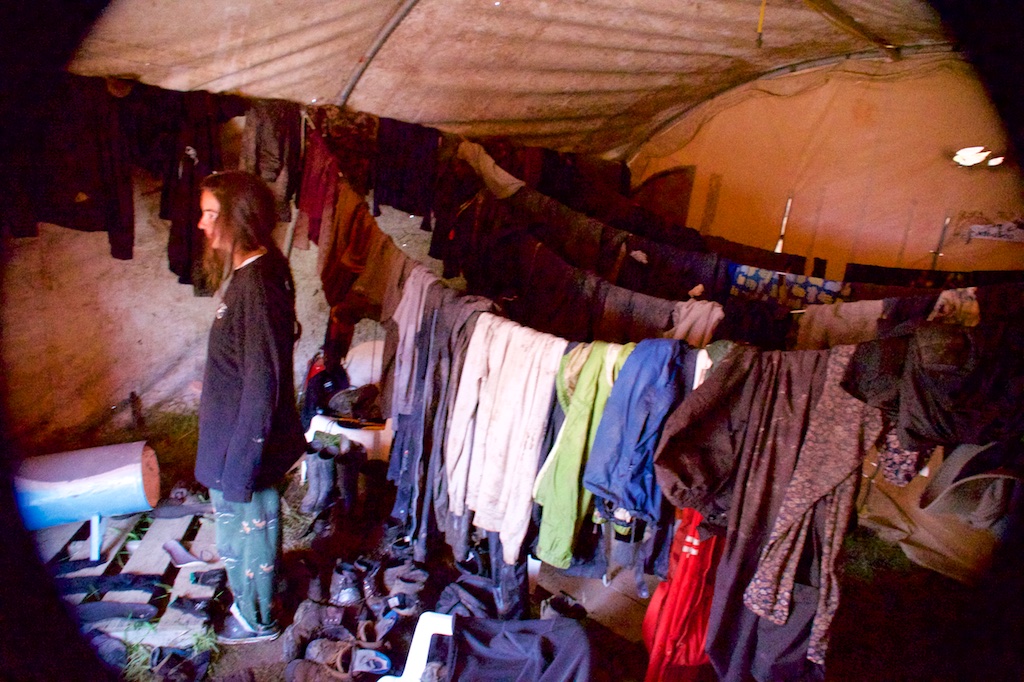
The “Dry” Tent
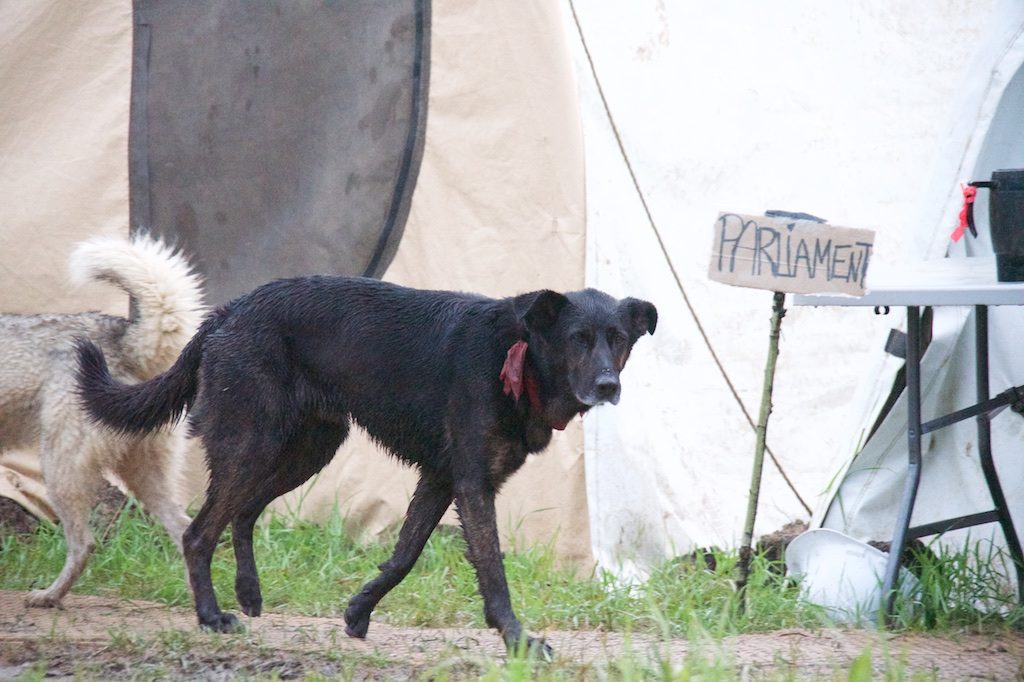
Dexter heading for Parliament
The admin tent had a corrugated cardboard sign that read “Parliament.” The colourful row of portable toilets was on the west side of the camp.
With the aid of the bedraggled instruction sheet and some trial and error, Eddy and Imad helped me put up my little abode in an area with lush grass, for which I was most grateful, and then it was straight to bed to be up for breakfast at 6 a.m. Well, it wasn’t quite straight to bed for me; I still had to figure out which valve to open and which one to close and how to work the internal manual pump on Bob’s borrowed green air mattress.
A hearty breakfast was savoured in the dining tent (with a sign “Messy Lane”) where I got to meet some of the other tree planters.
- Mel, the beloved cook
We all made lunches from the food their highly-esteemed cook, Mel, had put out. Imad recommended with bright eyes that I snap up a couple of the peanut butter brownies to replenish my food fuel supply later in the day. Yes!!!
Chapter 3 – The Rollagon Ride
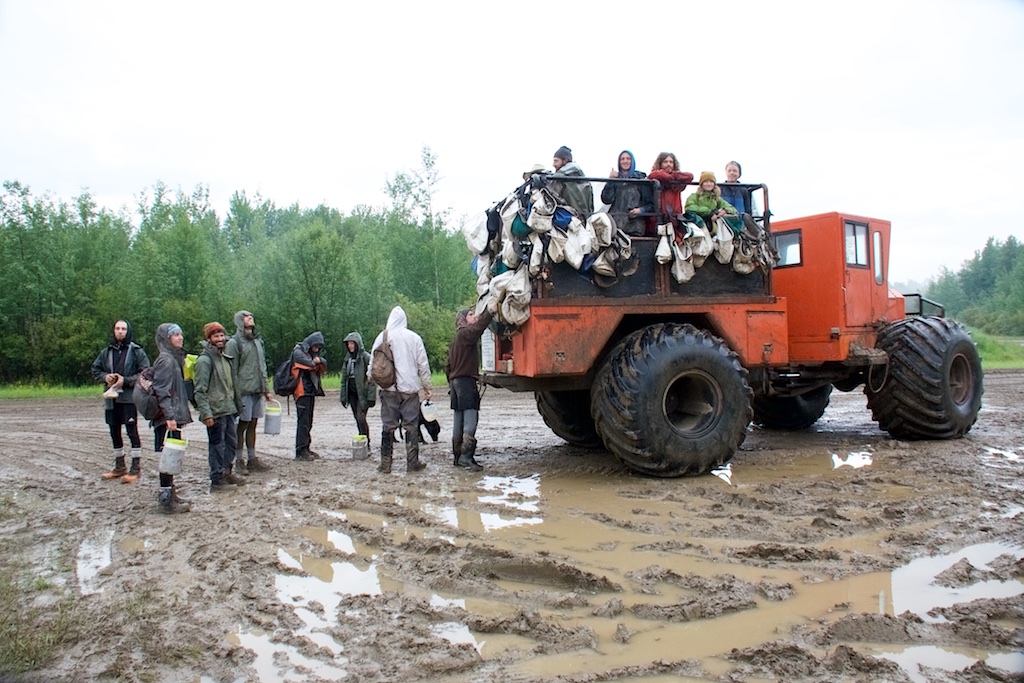
Apparently, I had arrived just in time to be too late to get a helicopter ride. They were now using the Rollagon, an all-terrain vehicle with huge wheels and low ground pressure that can carry a lot of tree planters, but … it … doesn’t … go … very … fast …
On the previous day, it was pouring rain when they returned from the cut block. The lucky newly-planted saplings got a good soaking, but the unlucky tree planters got the same soaking because there is no cover on the back of the Rollagon, thus the crowded “Dry” tent.
Departing just after 7 a.m., Maya drove the old orange Friendly Giant about an hour down muddy terrain and carefully over a narrow bridge with on-the-ground guidance from Tedesi, one of the crew bosses, who had arrived there previously by quad.
- Maya the Manager
- driving the diesel Roly
We reached a place that was too rough and muddy even for the Rollagon, and everyone got out. There were two crews, one led by Will and one by Tedesi. After receiving instructions, everyone picked up their tree-planting gear and backpacks and big water jugs and walked over two kilometres to get to the cut block.
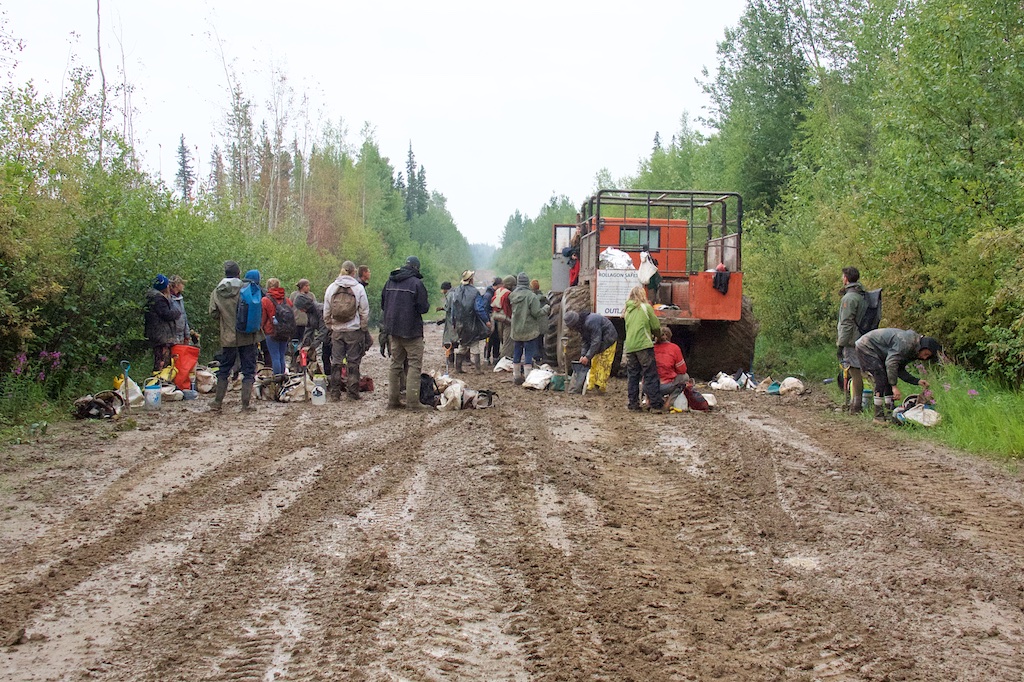
- Crew Boss Tedesi
- Crew Boss Will

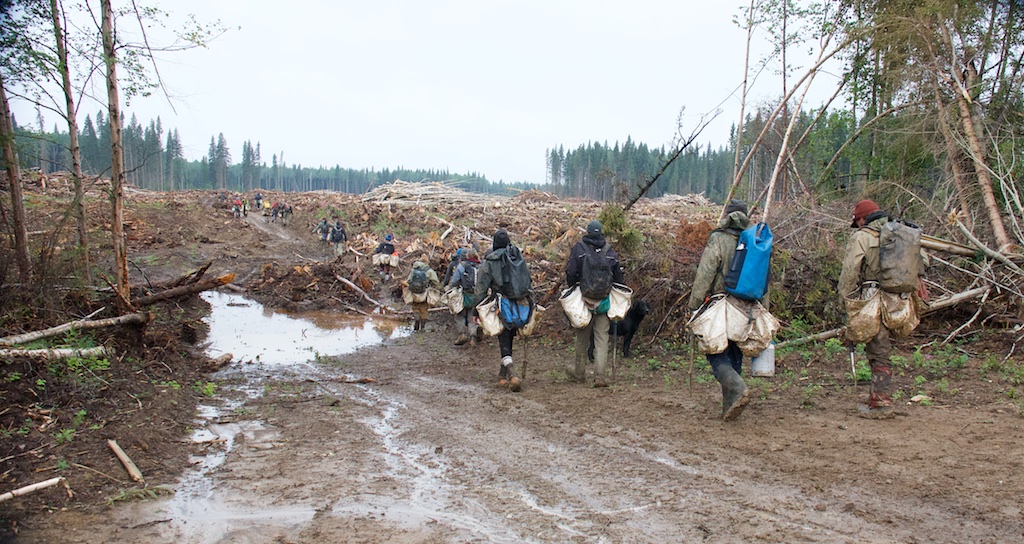
I photographed them from behind as they marched on like soldiers, slogging through slippery rough terrain up and over a small hill. The goal was to finish planting this cut block today so they wouldn’t have to make this long trek again. It was going to be a long day.
Previously, when I had thought of tree planters, I thought, “What a nice job that would be – to plant trees.” I could see myself doing that if I was still in my 20s.
I had no idea.
Chapter 4 – At the Cut Block

Crew Boss Will
I photographed Eddy first. He was planting in an area where fireweed, one of my favourite wildflowers, had started blooming. My husband says he and his cousins called them “purple rockets.” I call them “the boreal flower of hope” because they are often the first flower to bloom after a forest fire or disturbance.
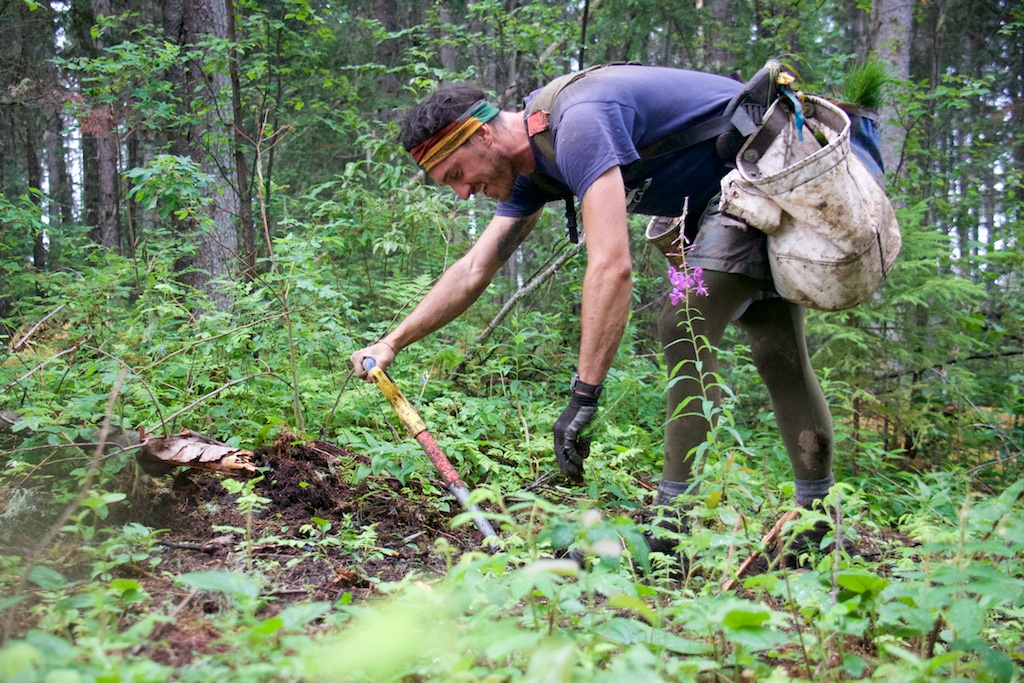
Eddy from Pennsylvania planting trees in northern Alberta
I wondered how Eddy knew where to plant. The cut block was not like a garden with raked soil and row markers. It looked more like the giants in the sky had been playing “Pickup Sticks” with a bunch of other stuff thrown in and never picked up their sticks.
I wondered how much that big white box of saplings weighed that Eddy was packing around, and where the trees came from, and how much his planting bag with pouches full of saplings would weigh. And “Doesn’t your back ache from bending over, again and again, all day long?”
What I didn’t have to wonder was why he was chosen and celebrated as the fastest rookie tree planter of the year. Wow! Moving that smoothly over rough terrain would require highly-developed kinesthetic intelligence.
I headed off like the paparazzi to find another planter to pester. I had been shown a map of the cut block, but I’m so directionally challenged I don’t even know which way to turn when the GooGal says “Proceed to the route,” on GoogleMaps, so I decided to just wander around and hope for the best.
I had been told that a group of white boxes is a planter’s cache, so I had landmarks to guide me. The Deliverers, Danny and Aaron, with the help of Loukes, the Checker, and other “Parliament” people, were going about on all-terrain vehicles, finishing up depositing the boxes of saplings for each cache.

Loukes delivering boxes of pine saplings to a planter’s cache
Mud’s the Word – a damsel in distress
The quad trail was slippery but looked like the easiest route compared to climbing over the debris between the trenches in the planting area. I was thinking “Ah…to be in the wilderness…away from it all…” when I was jolted back into cyber reality by the bold piano riff intro to “Bad to the Bone”, telling me that Telus actually provides cell phone coverage in the Chinchaga.
I fumbled to get my backpack straps out from under my camera strap so I could reach the side pocket and dig out my iPhone and stop the blaring ring tone. “Hello?” It was a DonaBona Cards customer. I had to stop walking because I couldn’t focus on customer service and manoeuvre in muck at the same time, all the while trying to give the impression I was sitting in a tidy office, nicely dressed, writing down her instructions.
By the time I finished the phone conversation, I looked down to see that my trusty rubber boots had sunk into over a foot of mud, and they weren’t budging. I had my backpack in my left hand, my phone in my right and my Nikon with an extended zoom lens hanging from the camera strap over my left shoulder and resting on my right hip. And there was no one around.
It appeared the only way out of my predicament would be in my sock feet, but I hadn’t thought to bring an extra pair of $100 merino wool high-compression old-lady socks, and the day had just begun!
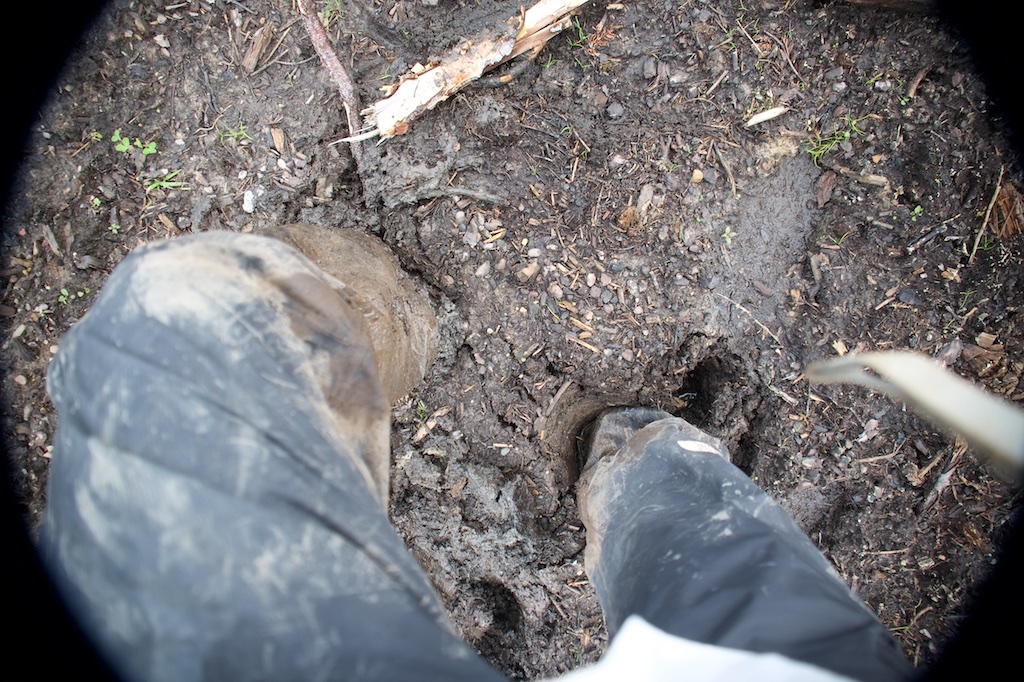
If I curled my toes upward on my right foot and pulled hard enough, I might be able to pull the boot out, but I would almost certainly lose my balance if/when the boot came loose, and then my whole body would be sinking into this slough of despond, and all they would find would be my Nikon being held high with my right arm.
And then along came Danny on a quad, driving, not on the trail, but over the jagged cut block terrain. As he got closer, he looked at me with a grin and said, “Can I help you?”
“Well as a matter of fact, yes! I’m a damsel in distress.”
He got off the quad, walked through the mud and graciously offered me a hand so I could keep my balance while schlurping my boots out of the goo. I profusely thanked my hero of the day. He smiled and said, “See that blue tape? That means don’t go there.” I laughed “Gotcha!” and walked on in freedom.
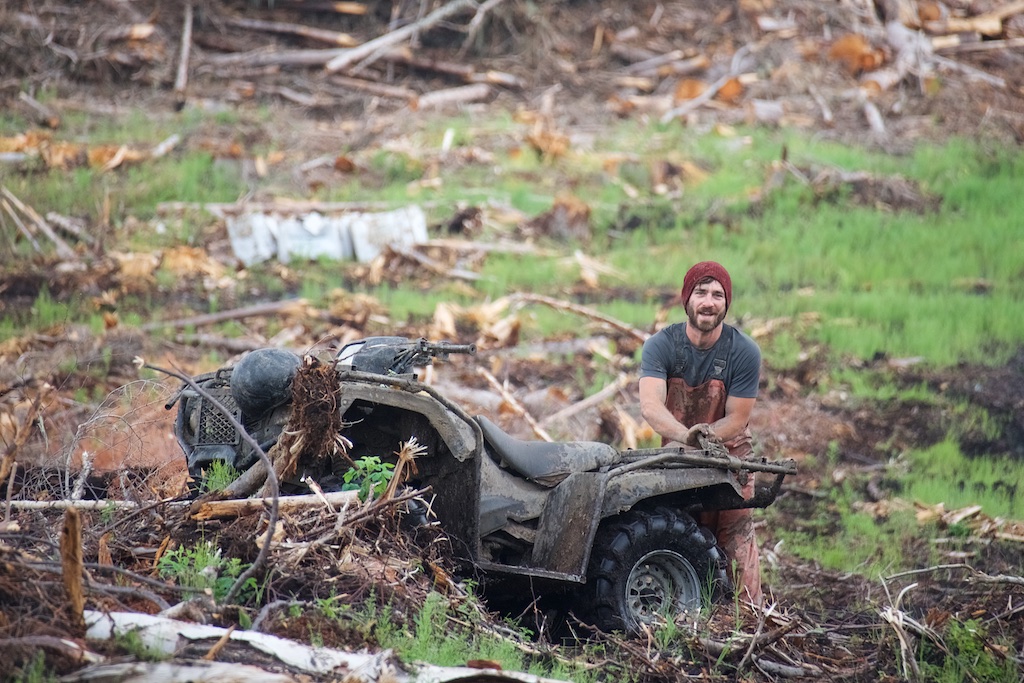
Danny the deliverer!
Superhumans
When I would spot another tree planter, I would try to get ahead of him or her so I could photograph their work from the front, but most of them could plant faster than I could walk on that cut block! These people are super-human athletes with highly-developed skills of strategy and improvisation.
They’re walking over logs, upended tree roots, clods of dirt, through puddles that’ll suck your boots off if you don’t duct tape them in place… and they just keep going…
Drive the shovel in the ground with one hand while you reach back for a sapling from your bag with the other, twist the shovel to make the opening, insert the sapling making sure not to bend the root or bury it too deeply, remove the shovel and stomp the soil in place with your boot as you step forward to find the next planting site, drive the shovel in the ground…
- Taviana
- Tessa
- Alex
- Fellner
- Imad
- Karlo
- Niko
- Buck
- Jimbo
- Mac
- Jordi
- Ethan
- Martin
- Vanessa
- Karlo and Pepper
They seem to take the obstacles in stride, like this is some outdoor improv game, and develop a rhythm and get into a zone and just keep goin’ for 10.5 cents per tree. (There is growing consensus this rate should be increased!) Some listen to music as they go; some seem to plant to the beat of their own drum. Areas without trenches can make it difficult to find a rhythm. They get 11.5 cents per tree for more difficult terrain.
- Jimbo
- Karlo
- Dalton
- Sam
- Taviana
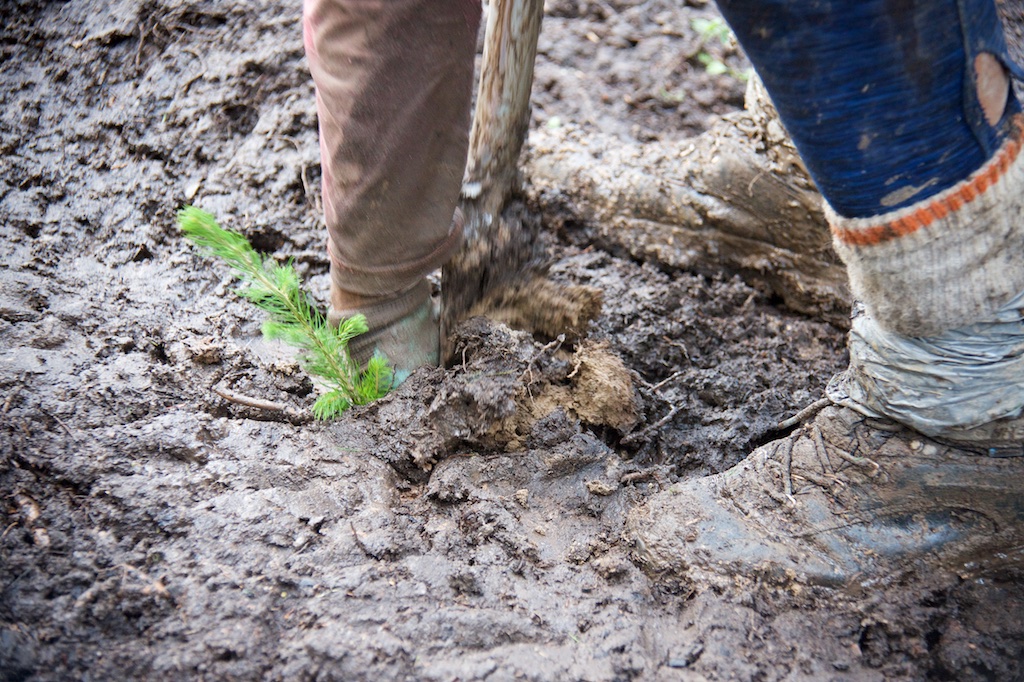
Tessa
The day I was there, it went from blazing sun to pouring rain and back again twice. They just adjust their clothing and keep going.
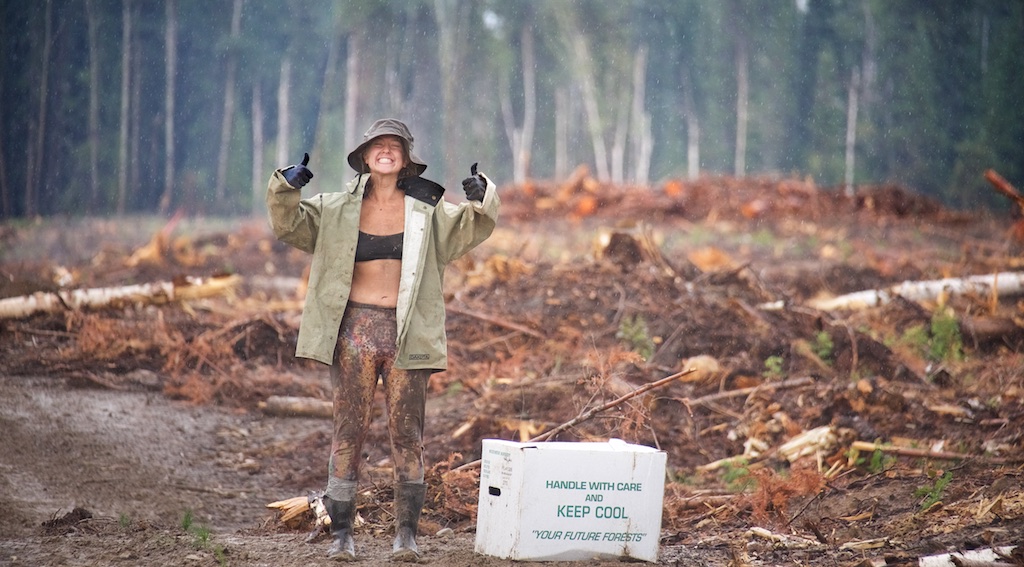
Taviana the Tree Planter – rain or shine she’s doin’ fine!
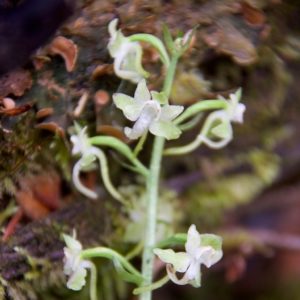 Meanwhile, I’m ducking under some big evergreen branches on the edge of the cut block, scrambling to find the lens hood, plastic bag and elastic band I brought as a makeshift rain protector for my camera. By the time I got it all together, and got my raincoat on over my soaked shirt and my waterproof Tilley hat on my head, photographed an intricate flower I’d never seen before, and got back out on the cut block, the rain had started to ease up. Sigh. I had so wanted to photograph them planting in the rain.
Meanwhile, I’m ducking under some big evergreen branches on the edge of the cut block, scrambling to find the lens hood, plastic bag and elastic band I brought as a makeshift rain protector for my camera. By the time I got it all together, and got my raincoat on over my soaked shirt and my waterproof Tilley hat on my head, photographed an intricate flower I’d never seen before, and got back out on the cut block, the rain had started to ease up. Sigh. I had so wanted to photograph them planting in the rain.
The Brownies
It was then I decided to bring out Mel’s precious chocolate peanut butter brownies. I had stopped for lunch earlier in the day, but now I was wet and hungry and my feet were hot and sweaty. I took off my backpack and found a somewhat level stump to sit on, took the first squished brownie out of the little zip-lock bag and ate it like I was a starving child. Then I kicked off my boots to let my feet breathe and slowly savoured each bite of the last precious morsel. A deep breath of gratitude made the world smell good. And the tree planters just kept going…
The Speed of Light
I was told Dalton, the guy with the dreads, was their fastest planter. I gave up trying to get ahead of him and just waited until he got to the end of his section and turned around. Even then I didn’t have long before I had to get out of the trench to let him past. I had to increase the ISO setting on my camera to avoid motion blur.
I could hear in his breath how hard he was working and said, “If I worked at that pace for one minute I’d have to rest for five.” He smiled for the camera, said something about nine hours, and just kept going.
Bag Up!
When you’re being paid per tree, there’s great motivation to develop tree planter’s time management skills. You don’t want to waste steps going back and forth to your cache. Here’s the strategy: The heavier you load your bag the faster you want to plant! The boxes of saplings weigh 35-40 lbs. depending on the stock. If they’re wet they’re even heavier. Many of the planters load one full box of about 270 trees at a time when they bag up. You definitely want to lighten your load as fast as you can, especially when climbing over logs, stumps and brush. “It’s a tricky thing to do, for sure,” says Maya. I was pleased to see the saplings are grown nearby, in Fairview, Alberta, by Woodmere Nursery. The planters rip the tag off the end of each box they plant and turn these in for their pay.
- Saplings from Woodmere Nursery in Fairview
- Imad finally stops for lunch
- Plant fast! This is heavy!
- Alex bags up
- Taviana
- Vanessa

The saplings weigh more when they’re wet…
- …but Mac loads a full box anyway
- and then carries two boxes.
- I can’t believe this guy is still smiling!
Sharon Plants a Tree
Further along, Loukes introduced himself as the checker, ensuring the trees are planted to the right depth and density with straight roots. He offered to show me how to plant. I planted four trees while he took photos. I came to the conclusion that I might make $10/day if I took this up as my new career. It’s enlightening to learn just enough of a new skill to truly appreciate the experts.
- Not the speed of light
Chapter 5 – The Wildlife
Some bears were spotted on the cut block that day, but I didn’t get to see them. 🙁 I did see a wide-eyed squirrel looking for food ! I have sometimes thought that the squirrel might be my spirit animal. 😉

And Alex found my namesake! When a beautiful strong blonde tree planter with an inspiring smile saw me taking her photo, she motioned for me to come see the bird she had found on the ground. She said the bird was laying on some chicks. Neither of us knew what kind of bird it was, but when I posted photos on the Alberta Wildlife Photographers Facebook page, I was told it was a Common Night Hawk, a nocturnal insectivore, and that it’s an endangered species and difficult to find.
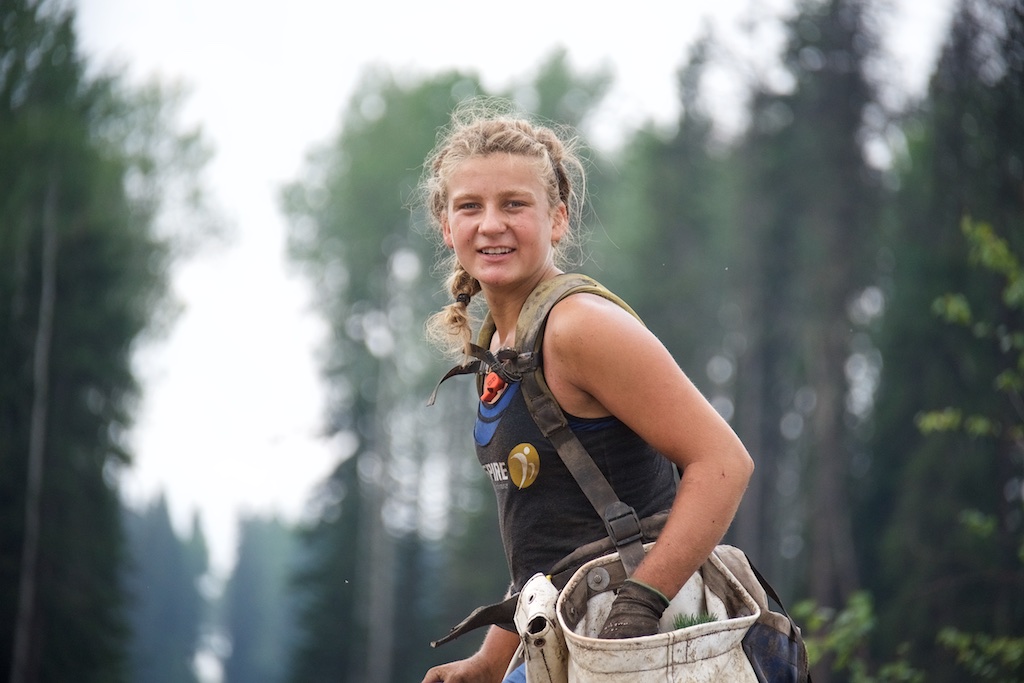
Alex, a university student, planting trees for the summer

Night Hawk – spotted by Alexandra White, photographed by Sharon Krushel, Chinchaga Wilderness, July 2019
I’m often called a night hawk because I tend to work until 2 or 3 a.m. I also spend a lot of time lying on my belly on the ground (taking photos). However, unlike the Night Hawk, I’m actually quite displeased when I realize I’ve swallowed a mosquito.
I feel privileged to have met my namesake in the wilderness and to have looked into her eyes. Thank you, Alex! It’s amazing that these Night Hawks will fly to South America for the winter without burning any fossil fuels!
You can see a beautiful Night Hawk in flight and read more about them here.
There’s a war going on against climate change, our precious wildlife need homes, and the world needs beauty. Keep calm and plant on!
Continued…
Find Part 2 of the story here.

